Dolgellau, formerly Dolgellau, is a town which lies on the River Wnion, a tributary of the River Mawddach, and was the county town of the historic county of Merionethshire. The town is surrounded by several ancient sites, so probably has ancient origins itself, and is now known as a central location for visiting Snowdonia and also for climbing Cadair Idris. The town was the centre of a gold rush in the 19th century, with the main mines being at Bontddu, Clogau St. David’s, and Gwynfynydd. The men, and one woman, of Dolgellau who fell during both World Wars are commemorated on the town’s war memorial, which is situated in the park by the bridge. There is a smaller memorial in the Parish Church. Following the end of World War Two, a further twenty-six names were added to the memorial to commemorate the men and one woman who fell during that conflict.

The Great War, 1914-1918
Richard Browne, Airman 3rd Class, 92780, Royal Flying Corps. Richard was the son of Richard and Ellen Browne of Maestalaran, Dolgellau. He married Margaret Marion Morris, of Dolgellau, on 8 May 1912, and the couple resided at 6, Idris Terrace. Richard was a Postman prior to the war. He enlisted into the Royal Welsh Fusiliers at Dolgellau on 8 December 1915, and was placed on the Army Reserve. On 26 June 1916 Richard was mobilised, and posted to the 2nd/5th (Reserve) Battalion, Royal Welsh Fusiliers. On 11 July 1916 he was discharged after having been deemed unlikely to become an efficient soldier, due to having hearing problems. Undeterred, he re-enlisted into the Royal Flying Corps, and was posted to Egypt, joining the 55th Kite Balloon Section, Royal Flying Corps. On 31 December 1917, Richard was working aboard a ship in the entrance to Alexandria Harbour, when the ship struck a mine and sunk. Richard was drowned in the incident. The 33-year-old is commemorated on the Chatby Memorial, Alexandria, Egypt.
George Collins, Private, 22042, King’s Own Shropshire Light Infantry. George was the son of George and Mary Collins, of Ganllwyd, Dolgellau. He enlisted at Market Drayton into the King’s Shropshire Light Infantry soon after the start of war, and after completing his training was posted to the 2nd Battalion, King’s Shropshire Light Infantry. The battalion had been in France since 21 December 1914, attached to 80 Brigade, 27th Division. On 4 December 1915 the Division landed in Salonika, where it had been transferred to assist the Greek Army, following a combined Austrian and Bulgarian invasion of their country. George probably joined the battalion in 1916. The Division remained in Salonika for the duration of the war, taking part in several pitched battles, notably the Battles of Doiran. George was killed in action in Salonika on 11 June 1917, aged 27. He is buried in Mikra British Cemetery, Kalamaria, Salonika.
Frank Nevel Coops, Sergeant, 8676, Cheshire Regiment. Frank was born in Alderley Edge, Cheshire on 8 March 1888, the son of Henry and Jane Coops. Following the death of his mother in 1905, his father Henry married Ellen Jane Williams, a Domestic Servant from Dolgellau in 1908, and the couple moved from Alderley Edge to 2, Wenallt Villas, Dolgellau. Frank had served with the 4th Battalion, Cheshire Regiment (Volunteers) prior to enlisting at Chester into the 3rd Battalion, Cheshire Regiment on 22 October 1907. Upon the outbreak of war, Frank was in India with the 2nd Battalion, Cheshire Regiment. The battalion landed at Devonport on 24 December 1914, joining 84 Brigade, 28th Division, and landed at Le Havre on 17 January 1915, before taking up positions in the Ypres Salient. Frank was wounded soon afterwards and evacuated home on 28 January. Following his recovery, he was posted to the 11th Battalion, Cheshire Regiment, which was attached to 75th Brigade, 25th Division, and landed back in France with his new battalion on 26 September 1915. The Division initially moved to the Ploegsteert sector for trench initiation, then spent much of February in Strazeele. By April the Division was in the Neuville-Saint-Vaast area. The Division defended Vimy Ridge against a German attack in May 1916. They then moved to the Warloy area at the end of June and attacked on 3 July near Thiepval. The Division then moved back to billets in Albert, before moving forward again and took part in an attack from Ovillers and the captured German line at La Boiselle during the morning of 14 July 1916. Frank suffered severe multiple gunshot wounds to his groin and genitals during the assault on 14 July and was evacuated to the 44th Casualty Clearing Station at Puchevillers, where he died of his wounds on 17 July 1916, aged 28. He is buried in Puchevillers British Cemetery, France.
David John Davies, Private, 291274, Royal Welsh Fusiliers. David was the son of David and Anne Davies, of Brynteg, Llanfachreth. He lived at Tyddynmawr, Islawrdref, Dolgellau prior to the war. David enlisted at Dolgellau into the 3/7th Battalion, Royal Welsh Fusiliers on 23 November 1915, and was posted to Park Hall, Oswestry for training. On 29 May 1916 David was posted to Egypt to join the 1/7th Battalion, Royal Welsh Fusiliers, which was attached to 158 Brigade, 53rd (Welsh) Division. The Division was attached to the EEF, guarding the Suez Canal, and was preparing to launch an offensive into Palestine on 26 March 1917. David was wounded in the head and taken prisoner by the Turks at the First Battle of Gaza on 26 March 1917. He was reported to have written to his parents a letter dated 3 April 1917, and was then reported to have died in hospital in Gaza on 19 April 1917 of his wounds. Further investigations by the War Office could not be positive of this report, but David was later adjudged to have died at some time between 3 April and 3 October 1917. The official date of his death is therefore recorded as the latter, 3 October 1917, but the Turkish report stating 19 April is most probably correct. David was 21 years old, and is commemorated on the Jerusalem Memorial, Israel.
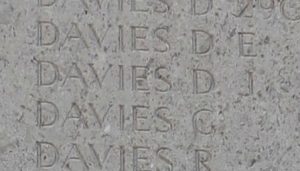
David Oswald Davies, Captain, Royal Welsh Fusiliers. David was born at Llanfyllin in 1865, the son of David Milton Davies and Mary Davies (nee Evans). His father had died in 1869, and David moved with his mother and brother Albert to live with their Uncle Evan Evans at Dovey View, Machynlleth. After obtaining his BA at Bangor University, David became a Master at Llangollen Grammar School. He had played international football for Wales in his youth. He later qualified as a Solicitor and moved to Barmouth where he established a thriving business, becoming very well known in the town. David served with the V.T.C. at Barmouth, and following the outbreak of war was commissioned into the 7th Battalion, Royal Welsh Fusiliers, and was posted to Newtown and then to Park Hall, Oswestry, where he helped train new recruits. David took ill early in 1917 and died of disease at Barmouth on 22 May 1917, aged 51. He is buried in St. Mary’s Churchyard, Llanaber.
Gomer Davies, Private, 290537, Royal Welsh Fusiliers. Gomer was the son of Margaret Davies, of Dolgellau. He married Ellen Evans in 1910, and the couple lived at Park Lane, Dolgellau, with their four children. Gomer worked as a Mason prior to the war. He enlisted at Dolgellau into the 7th Battalion, Royal Welsh Fusiliers on 8 August 1914. The battalion was a Territorial unit, which mobilised for war at Newtown in August 1914, as part of North Wales Brigade, Welsh Division and moved to Conway until the end of the month, before moving to Northampton. In December the Division moved to Cambridge and then in May 1915 to Bedford, where the Division was numbered and the formation became 158 Brigade, 53rd (Welsh) Division. On 19 July 1915 the entire Division sailed from Devonport for Imbros and on 9 August 1915 landed at Suvla Bay. The Division saw heavy fighting over the coming days, then as the fighting died down winter hit the Peninsula, and the weather was so bad that during one downpour, the bodies of the dead were washed from their graves into the trenches. The Division was eventually evacuated from Gallipoli in December 1915, moving to Egypt to join the EEF, and helped guard the Suez Canal before taking part in operations to drive the Turks out of the Sinai. The EEF then turned its attention onto driving the Turks out of Palestine, and on 26 March 1917 launched its first offensive against the coastal city of Gaza, which guarded the road to Jerusalem. Initial gains during the day were lost when the assaulting divisions lost touch with each other and communication broke down when a thick fog cloaked the battlefield. A second assault on Gaza was launched on 17 April, which again failed, and the EEF was reorganised, coming under the command of Sir Edmund Allenby, before a third offensive was launched on the night of 1 November 1917 on a broader front, from Gaza to Beersheba. This time the Allies broke the Turkish lines, clearing the way to Jerusalem, and following the fall of the Holy City, continued to advance northwards. Gomer was killed in action at Ghoraniyeh Bridge, on the River Jordan, on 29 March 1918, aged 36. He has no known grave and is commemorated on the Jerusalem Memorial, Israel.
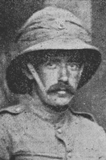
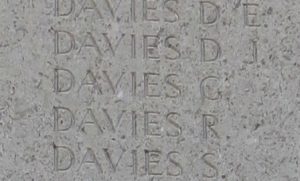
Hugh Davies, Private, 291212, Royal Welsh Fusiliers. Hugh was born in Pentraeth, Anglesey in 1882, the son of Hugh and Mary Davies. The family later resided at Ivy Cottage, Dolgellau. Hugh enlisted at Blaenau Ffestiniog into the 3/7th Battalion, Royal Welsh Fusiliers on 15 November 1915 and joined the battalion at Park Hall, Oswestry. On 26 March 1917 Hugh embarked at Southampton for France, and was sent to No 5 Infantry Base Depot. On 16 April 1917 Hugh was posted to the 10th Battalion, Royal Welsh Fusiliers, which was by then attached to 76 Brigade, 3rd Division. He joined the battalion following its move from Wanquetin to the Arras front, where it had taken part in an attack on 8 April against the heavily defended village of Guemappe and had suffered over 200 casualties. By 14 April the battalion was back in Arras, then moved to a training ground near Daineville, which is probably where Hugh joined its ranks. On 23 April the battalion moved back to the front line and took over trenches in Monchy on 25 April, holding the line there over the coming days. On 3 May the battalion was relieved, and on the night of 10 May took over the front line again. Hugh was killed in action the following day, 11 May 1917. The 35-year-old has no known grave and is commemorated on the Arras Memorial, France.
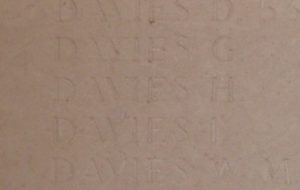
Thomas Donegan, Private, 33254, Royal Welsh Fusiliers. Thomas was born at 24, Old Bridge, Clonmel, Tipperary in 1886, the son of John Donegan. He had left Ireland after enlisting into the Connaught Rangers as a young man, and was court-martialled in India for destroying military property, and was sentenced to 12 months imprisonment. He was then discharged from the army and by 1911 he was living in Wales. He re-enlisted into the 8th Battalion, Welsh Regiment at Swansea on 18 August 1914, but was discharged as unfit on 18 February 1915. He again enlisted at Dolgellau on 17 August 1915 into the 3rd Battalion, Royal Welsh Fusiliers, and on 20 December 1915 was posted to France, joining the 2nd Battalion, Royal Welsh Fusiliers, which was attached to 19 Brigade. On 5 March 1916 he was sent back to Britain and was soon in trouble with the military authorities and was court-martialled on 30 June 1916 before being detained for misconduct. He returned to the battalion, but was transferred to the 2nd (Garrison) Battalion, Royal Welsh Fusiliers, embarking for Egypt on 20 October 1916. He served with the battalion until 8 December 1917, when he was sent home for attempting to shoot a fellow soldier, and upon arrival in England, was sent to D Block, Netley Military Hospital. A week later he was sent to Dykebar War Hospital, near Paisley, then a week later he was transferred to Crooksten War Hospital, Nitshill, Glasgow. Thomas was found hanging in his room on 20 March 1918. The subsequent court of inquiry ruled that he had committed suicide. Thomas was buried with full military honours in Hawkhead Cemetery, Paisley, Scotland. He does not appear to be commemorated anywhere locally.

William Donnan, Lieutenant Colonel, Indian Army. William was born in India on 21 September 1867, and was commissioned as Second Lieutenant in the Lincolnshire Regiment on 11 February 1888. He was transferred to the Indian Staff Corps as Lieutenant on 12 August 1899 and was made Captain on 11 February 1899. He served in Somaliland 1902-04, with the Military Accounts Department, Somaliland Field Force. He later served as Examiner of Commissariat Accounts and Paymaster at Rangoon in 1904. He was promoted to Major on 11 February 1906 and to Lieutenant-Colonel on 11 February 1914. William married Ethel Louisa Jelf-Reveley, of Bryngwin, Dolgellau, in India in 1915, before retiring from the army on 9 March 1916, receiving a pension until 11 January 1918. He was reinstated in the Indian Army from 12 January 1918 with the rank of Lieutenant-Colonel, and was posted to Basra, Mesopotamia. He died in Basra of heatstroke on 13 August 1919, aged 52 and is buried in Basra War Cemetery. His widow, Ethel, returned to Bryngwin with their son, William Henry Donnan. She never remarried, and died on 23 December 1962.
David John Edwards, Corporal, 6237, Royal Welsh Fusiliers. David was the son of Dorothy Ann Parkes, of 5, Aber View, Corwen. He worked as a builder’s labourer and had served with the Militia prior to enlisting into the 2nd Battalion, Royal Welsh Fusiliers at Wrexham on 6 December 1899. In January 1901 David was posted to China, and served there for almost two years Before going to India and then Burma with the battalion. The battalion remained in Burma until returning to England in March 1914, and was a vastly experienced unit when it embarked for France to join the BEF following the outbreak of war. Instead of going into the firing line, to the frustration of the men, the 2nd Battalion, Royal Welsh Fusiliers landed at Rouen and was put to work on Lines of Communications. On 22 August 1914 the battalion joined 19 Brigade at Valenciennes, and finally on 12 October 1914 became attached to the 6th Division. On 27 November 1914 David returned to England and was posted to the 3rd RWF. He returned to France on 1 April 1915, and saw further service in France until 6 December 1916, when he again returned to England and was posted to the Depot. David served with the 3rd Garrison Battalion of the regiment in Ireland until after the Armistice, surviving the war, but took ill and died of a brain haemorrhage at Crosshaven, Ireland on 20 November 1918, aged 40. His remains were brought home for burial in St. Mary’s Churchyard, Dolgellau.
John Edwards, Private, 2694, Royal Welsh Fusiliers. John was the son of William and Ellen Edwards, of Green Lane, Dolgellau. He worked as an ore crusher at the Turf Copper mine prior to the war. John enlisted at Dolgellau together with his brother Richard into the 7th Battalion, Royal Welsh Fusiliers. The battalion was a Territorial unit, which mobilised for war at Newtown in August 1914, as part of North Wales Brigade, Welsh Division and moved to Conway until the end of the month, before moving to Northampton. In December the Division moved to Cambridge and then in May 1915 to Bedford, where the Division was numbered and the formation became 158 Brigade, 53rd (Welsh) Division. On 19 July 1915 the entire Division sailed from Devonport for Imbros and on 9 August 1915 landed at Suvla Bay. The infantry moved off the beaches into the bush, but due to a lack of maps and no knowledge of the terrain, many of the units became disorientated, and the situation became chaotic. John was killed in action during heavy fighting the following day, 10 August 1915. The 26-year-old has no known grave and is commemorated on the Helles Memorial, Gallipoli. His brother Richard was tragically killed on the same day.
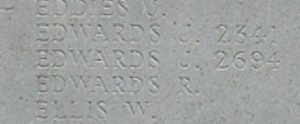
Richard Edwards, Private, 2739, Royal Welsh Fusiliers. Richard was the son of William and Ellen Edwards, of Green Lane, Dolgellau. He married Ellen Morgan in 1904, and the couple lived at Upperfield Street, Dolgellau. Richard worked as a copper miner prior to enlisting at Dolgellau together with his brother John into the 7th Battalion, Royal Welsh Fusiliers. The battalion was a Territorial unit, which mobilised for war at Newtown in August 1914, as part of North Wales Brigade, Welsh Division and moved to Conway until the end of the month, before moving to Northampton. In December the Division moved to Cambridge and then in May 1915 to Bedford, where the Division was numbered and the formation became 158 Brigade, 53rd (Welsh) Division. On 19 July 1915 the entire Division sailed from Devonport for Imbros and on 9 August 1915 landed at Suvla Bay. The infantry moved off the beaches into the bush, but due to a lack of maps and no knowledge of the terrain, many of the units became disorientated, and the situation became chaotic. Richard was killed in action during heavy fighting the following day, 10 August 1915. The 35-year-old has no known grave and is commemorated on the Helles Memorial, Gallipoli. His brother John was tragically killed on the same day.
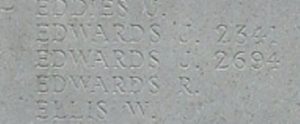
Edward Evans, Private, 291469, Royal Welsh Fusiliers. Edward was the son of John and Jane Evans of Blaenyddol, Rhydymain. He worked as a farm labourer and postman prior to the war. Edward enlisted into the 7th Battalion, Royal Welsh Fusiliers at Dolgellau on 10 December 1915. He was initially placed on the Army Reserve, and then mobilised on 17 February 1916, joining the 2/7th Battalion, Royal Welsh Fusiliers at Park Hall, Oswestry. On 13 March 1917 Edward arrived in France, joining No 5 Infantry Base Depot, and was posted to the 2nd Battalion, Royal Welsh Fusiliers, which was attached to 19 Brigade, 33rd Division, joining the battalion at Adinfer on 3 May, together with 80 other men. The battalion then marched to Moyenville on 12 May and on 15 May moved into the support line on the St. Leger to Henin road. On 18 May 1917 the 2nd RWF relieved the Cameroonian’s in the Croisilles Sector, facing the Hindenburg Line. Two days later the Division made an assault on the Hindenburg Line, successfully taking the front line, but failed to break through and take the support trench. The 2nd RWF was then placed back in reserve, before taking over the front line again on 21 May, remaining there until launching another assault on the Hindenburg Line on 27 May 1917. The attacking troops came under heavy machine-gun fire as they attempted to break the German defences, and during the days fighting the 2nd RWF alone suffered over 120 casualties. Edward had been killed in action during the days fighting. The 25-year-old has no known grave and is commemorated on the Arras Memorial, France.
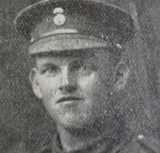
Evan William Evans, Corporal, 185934, Royal Engineers. Evan was the son of Robert and Anne Evans, of 43 Hafod Oer, Dolgellau. He was in education at Aberystwyth University prior to enlisting at Montgomery into the Montgomeryshire Yeomanry. He was subsequently transferred to the Royal Engineers, and posted to France, joining ‘N’ Special Company, Royal Engineers, which was a specialist gas warfare unit which used the Livens Projectors to fire gas shells. The company was initially attached to the 3rd Army, and saw service at Monchy and Auchy, before moving to Diksmuide on 9 October 1917, just north of the Ypres Salient. Evan was in action with the company, supporting their Belgian allies, when he was killed in action alongside another two men of their company on 14 November 1917. The 20-year-old is buried alongside his comrades in Steenkerke Belgian Military Cemetery, Belgium. His younger brother, Hugh Trebor Evans, had been killed just weeks earlier.
Hugh Edward Evans, Private, 81734, Royal Army Medical Corps. Hugh was the son of Griffith and Mary Anne Evans of Glan Eiddon, Rhydymain, Dolgellau. He was a student at the University of Wales, Bangor when he was conscripted into the army on 27 January 1916, and as a pacifist was posted to the Royal Army Medical Corps. He was posted to Sheffield for training, and on 10 September 1916 embarked at Southampton for Salonika, to serve in the 36th General Hospital. Hugh served just over a year in a theatre of war that saw the Allies suffer as many men sick as actual casualties of war. He contracted malaria, and died of sudden heart failure following malaria at the 36th General Hospital, Salonika on 28 October 1917, aged 23. Hugh is buried in Mikra British Cemetery, Kalamaria, Salonika.
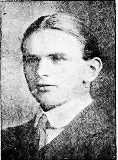
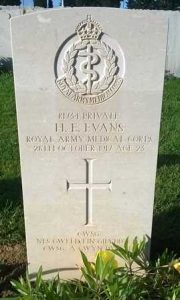
Hugh Trebor Evans, Private, 204457, Royal Welsh Fusiliers. Hugh was the son of Robert and Anne Evans, of 43 Hafod Oer, Dolgellau. He worked as a farm labourer prior to enlisted at Dolgellau into the 4th Battalion, Royal Welsh Fusiliers on 4 May 1917. After completing his training, Hugh embarked for France at Southampton on 3 August 1917, and was posted to No. 5 Infantry Base Depot at Rouen. He was then posted to the 16th Battalion, Royal Welsh Fusiliers, joining the battalion at Ypres on 25 August 1917. The battalion was attached to 113 Brigade, 38th (Welsh) Division, and had just taken part in heavy fighting during its assault on the Pilckem Ridge on 31 July. When Hugh arrived at the front, the 16th RWF was at work on the Canal Bank, supplying working parties to the troops in the front line. The battalion moved back into the front line on 30 August, but the Divisions time at Ypres was drawing to a close, and on 10 September the Division began to move to a more peaceful sector on the Lys, to rest and rebuild. On 17 September the 16th RWF moved into the front line in the Bois-Grenier Sector, to begin a routine tour of duty. On the morning of 19 September 1917, the Divisional artillery launched a barrage on the German lines, and in retaliation the Germans shelled the Divisional front with Heavy Trench Mortar fire. Hugh was among twelve men killed and 21 wounded during the day. The 19-year-old is buried in Erquinghem-Lys Churchyard Extension, France. His brother Evan was killed at Ypres some weeks later.
Hywel Evans, Private, 242715, South Lancashire Regiment. Hywel was born at Llanfachreth in 1887, the illegitimate son of Elizabeth Evans, of Penrhos Isaf. He was raised by his grandparents, Morris and Jane Evans, before becoming a carter at Felin Newydd, Rhydymain. Hywel married Jane Ellen Williams on 16 December 1913 and the couple set up home at Tyddynynoch, Brithdir. He enlisted into the South Lancashire Regiment at Wrexham on 25 October 1916, and after completing his training was posted to France on 17 February 1917, joining the 2/5th Battalion, South Lancashire Regiment. He served on the Western Front until taking ill, and returned to Britain for treatment on 23 November 1917. It was almost five months until Hywel was fit enough to re-join his unit, and he arrived back in France on 8 April 1918, before being posted to the 2/4th Battalion, South Lancashire Regiment. The battalion was attached to 172 Brigade, 57th (West Lancs) Division in the Gommecourt area. It remained here until moving to the Arras sector to take part in the launch of the great Allied offensive on 21 August 1918, and began driving towards the Hindenburg Line. The 2/4th South Lancs were in billets at Mercatel on the opening day of the offensive and on 27 August moved forwards to take up the offensive, with orders to assault the village of Hendecourt, and at 12.30 on 28 August 1918 launched its attack behind a creeping artillery barrage. Within four hours the battalion had successfully taken the village, but had suffered some losses. Hywel was among twenty men killed during the days fighting. The 31-year-old is buried in Dury Crucifix Cemetery, France. He is also commemorated on the Dinas Mawddy memorial.
John Hugh Evans, Private, 290581, Royal Welsh Fusiliers. John was the son of John and Margaret Evans of 5, Park Lane, Dolgellau. He worked as a Collier prior to enlisting at Dolgellau into the 7th Battalion, Royal Welsh Fusiliers on 15 August 1914. The battalion was a Territorial unit, which mobilised for war at Newtown in August 1914, as part of North Wales Brigade, Welsh Division and moved to Conway until the end of the month, before moving to Northampton. In December the Division moved to Cambridge and then in May 1915 to Bedford, where the Division was numbered and the formation became 158 Brigade, 53rd (Welsh) Division. On 19 July 1915 the entire Division sailed from Devonport for Imbros and on 9 August 1915 landed at Suvla Bay. The Division saw heavy fighting over the coming days, losing many men, and when the fighting calmed down, winter hit the Peninsula, with rain so heavy that dead bodies were washed out of their graves into the trenches in places. The Division was eventually evacuated from Gallipoli in December 1915, moving to Egypt to join the EEF, and helped guard the Suez Canal before taking part in operations to drive the Turks out of the Sinai. The EEF then turned its attention onto driving the Turks out of Palestine, and on 26 March 1917 launched its first offensive against the coastal city of Gaza, which guarded the road to Jerusalem. Initial gains during the day were lost when the assaulting divisions lost touch with each other and communication broke down when a thick fog cloaked the battlefield. John was killed in action at some time during the day. The 34-year-old has no known grave and is commemorated on the Jerusalem Memorial, Israel.
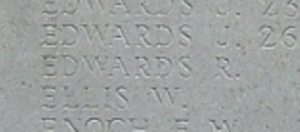
John Thomas Evans, Lance Corporal, 240742, Welsh Regiment. John was the son of Thomas and Mary Anne Evans, of 5, Fronheulog Cottage, Dolgellau. He lived with his Uncle, William Llewellyn, at 24, East Street, Pontypridd prior to the war, where he worked as a coal tipper. John enlisted at Pontypridd into the 5th Battalion, Welsh Regiment soon after the outbreak of war. The battalion was a Territorial unit, which mobilised for war at Pontypridd in August 1914, as part of South Wales Brigade, Welsh Division and moved to Scotland as part of the Forth and Tay Defences. In May 1915 the battalion moved to Bedford, where the Division was numbered and the formation became 159 Brigade, 53rd (Welsh) Division. On 19 July 1915 the entire Division sailed from Devonport for Imbros and on 9 August 1915 landed at Suvla Bay. The Division saw heavy fighting over the coming days, losing many men, and when the fighting calmed down, winter hit the Peninsula, with rain so heavy that dead bodies were washed out of their graves into the trenches in places. The Division was eventually evacuated from Gallipoli in December 1915, moving to Egypt to join the EEF, and helped guard the Suez Canal before taking part in operations to drive the Turks out of the Sinai. The EEF then turned its attention onto driving the Turks out of Palestine, and on 26 March 1917 launched its first offensive against the coastal city of Gaza, which guarded the road to Jerusalem. Initial gains during the day were lost when the assaulting divisions lost touch with each other and communication broke down when a thick fog cloaked the battlefield. John was killed in action at some time during the day. The 28-year-old has no known grave and is commemorated on the Jerusalem Memorial, Israel.
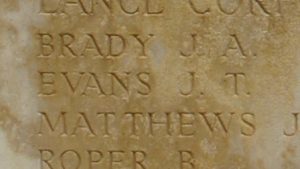
Richard Evans, Private, 38128, Welsh Regiment. Richard was the son of Edward and Elizabeth Evans of 4, Maescaled, Dolgellau. He lodged at 9, Coronation Place, Aberfan prior to the war, where he worked as a collier. Richard enlisted at Tonypandy into the 18th Battalion, Welsh Regiment. The battalion was raised as a Bantam Battalion in January 1915, made up of men of below average height, and was originally sent to Porthcawl attached to the 43rd (Welsh) Division. In July 1915 the battalion moved to Prees Heath, to join 119 Brigade, 40th (Bantam) Division, and moved to Aldershot before landing in France in June 1916. The Division originally moved to the front near Loos. Late in 1916 the Division moved south to the Somme, taking part in the Battle of the Ancre, and remained in the area over the winter. In March 1917 the Division followed the German withdrawal to the Hindenburg Line, passing Dessart Wood and Gouzeaucourt. The Division remained in this sector over the summer, before moving to Péronne on 9 October 1917 and entraining for Gouy-en-Artois, to begin training for the forthcoming Battle of Cambrai. On 1 November the Division began moving back to the front, and the 18th Welsh had reached Lucheux, where Brigade training was carried out over the coming days, before the Division took up its positions in the line near Anneux. On the morning of 23 November 1917, 119 Brigade launched its assault on Bourlon Wood, supported by a number of tanks. The 18th Welsh was, for now, in reserve, but was soon ordered to move forwards to enter the fray. Good progress was made throughout the day, but on the following morning the Germans counter-attacked, and the situation became critical, so other units moved forwards to support the 40th Division. Richard was killed in action in Bourlon Wood on 25 November 1917, aged 27. He has no known grave and is commemorated on the Cambrai Memorial, Louverval, France. His brother, Thomas, died of wounds in 1918.
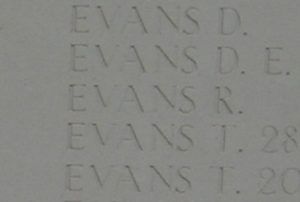
Richard Evans, Private, 7264, Welsh Regiment. Richard was the son of Thomas and Mary Evans, of Bontyrarran, Dolgellau. He worked as a Painter and Decorator at Cwmdare prior to the war, and married Kate Florence Hill there in 1908. Richard enlisted at Cardiff into the Welsh Regiment soon after the outbreak of war, and embarked for France on 23 November 1914, joining the 2nd Battalion, Welsh Regiment, which was attached to 3 Brigade, 1st Division, at Givenchy. The Division had suffered severe casualties since landing in France, and Richard would have been among a large number of re-enforcements posted out to bolster its ranks. The new front, near the village of Festubert, was an unpleasant sector, the land being waterlogged, making life in the trenches very hard on the men. The usual routine of rotation in the trenches was now underway. A half-hearted Franco-British attack began on 14 December, but was halted within three days. The Germans counter-attacked Festubert and Givenchy on 20 December and the 1st Division, in billets in Merville, was sent forwards to recapture Givenchy. Fighting continued in this sector over the Christmas period, although just to the North the famous Christmas Truce was being held at Ploegsteert Wood. On 8 January the 2nd Welsh was relieved, after 18 continuous days in the line, and moved to Bethune to rest. On 12 January the 2nd Welsh moved back into the line at Givenchy, to begin another lengthy tour. On 25 January the Germans attacked Festubert again, and the 2nd Welsh again took part in desperate fighting, beating back the Germans. Richard was wounded in action at some time after this, and was evacuated back to the Base Hospital at Boulogne for treatment. He died of his wounds there on 27 February 1915, aged 35, and is buried in Boulogne Eastern Cemetery, France. His was one of the four names added to the memorial after its unveiling in 1921. His widow, Kate, married Percy Rees in 1918, and died in 1968.
Richard Evans, Air Mechanic 2nd Class, 138487, Royal Air Force. Richard was the son of Hugh and Gwen Evans, of Meyrick Square, Dolgellau. He worked as a Picture Framer prior to the war. He enlisted into the Royal Flying Corps on 8 March 1915, and served in France, at No. 2 Aircraft Depot. The RFC merged with the RNAS in March 1918 to form the Royal Air Force, and Richard continued to serve in the new service, even remaining in France after the Armistice. Richard contracted pneumonia some months after the Armistice and died of pneumonia in the Casualty Clearing Station at Étrun on 7 April 1919, aged 35. He is buried in Duisans British Cemetery, Étrun, France.
Thomas Evans, Private, 89615, Royal Welsh Fusiliers. Thomas was the son of Edward and Elizabeth Evans of 3, Meirion Terrace, Brithdir, Dolgellau. He enlisted at Wrexham into the Royal Welsh Fusiliers, and was posted to France in the summer of 1918, joining the 13th Battalion, Royal Welsh Fusiliers, which was attached to 113 Brigade, 38th (Welsh) Division. He probably joined the battalion after the Division had launched its offensive across the flooded Ancre Valley on 21 August 1918, and began its slow advance towards the mighty Hindenburg Line. The Division had crossed the old Somme battlefields of 1916, taking Mametz Wood and Delville Wood, then advanced, seizing Morval and Sailly-Saillisel, before launching an attack across the Canal du Nord. Thomas was probably wounded when the 13th RWF took part in the Divisions assault on Mortho Wood, a heavily defended area, on 8 October. He was evacuated through the chain of dressing station to Casualty Clearing Stations, back to the 26th General Hospital, at Étaples, where he was being prepared to transfer back to Britain, but sadly died of his wounds there on 29 October 1918, aged 20. Thomas is buried in Étaples Military Cemetery, France. His brother, Richard, was killed in 1917.
William Evans, Private, M2/174927, Royal Army Service Corps. William was the Owen and Ann Evans, of Pandyrodyn, Dolgellau. He enlisted into the Army Service Corps, and was originally posted to the ASC Motor Transport Depot at Kempston Park for training. William took ill during the summer of 1918 and was brought to Hounslow Military Hospital, where he died of pneumonia on 14 July 1918, aged 28. His remains were brought home for burial in Dolgellau Nonconformist Cemetery.
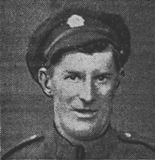
William Lewis Evans, Private, 2824, Royal Welsh Fusiliers. William was the son of Robert and Margaret Evans, of Dolgellau. He married Elizabeth Jones in 1903, and the couple lived at 9, English Terrace, Dolgellau. He enlisted at Newtown into the 7th Battalion, Royal Welsh Fusiliers. The battalion was a Territorial unit, which mobilised for war at Newtown in August 1914, as part of North Wales Brigade, Welsh Division and moved to Conway until the end of the month, before moving to Northampton. In December the Division moved to Cambridge and then in May 1915 to Bedford, where the Division was numbered and the formation became 158 Brigade, 53rd (Welsh) Division. On 19 July 1915 the entire Division sailed from Devonport for Imbros and on 9 August 1915 landed at Suvla Bay. The infantry moved off the beaches into the bush, but due to a lack of maps and no knowledge of the terrain, many of the units became disorientated, and the situation became chaotic. William was killed in action during heavy fighting the following day, 10 August 1915, aged 34. He has no known grave and is commemorated on the Helles Memorial, Gallipoli. His brother-in-law, Henry Jones, was killed alongside him.
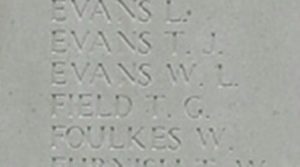
John Fortescue Finnis, Lieutenant Colonel, Indian Army. John was born at Abbottabad, Bengal, India on 14 February 1870, the son of Lieutenant Colonel John Finnis, 2nd Punjab Infantry, and Florence Stanley Finnis (nee McGowan). His father died in India in 1884, and his mother came to live at Rock Cottage, Dolgellau with her three daughters. John remained in India, after having been commissioned into the Indian Army, following in his father’s footsteps. In 1909 John married Nancy Elizabeth Campbell Galloway in India, and their son was born later that year. At the outbreak of war, John was commanding the 53rd Sikhs (Frontier Force). The Regiment was formed of four companies of Sikhs, two of Pathans, and one each of Punjabi Muslims and Dogras. Following the outbreak of war, the Regiment embarked from India for Egypt, then moved to Aden before being transferred to Mesopotamia in December 1915. John was killed in action soon afterwards, whilst leading his regiment on 14 January 1916, aged 45. He has no known grave and is commemorated on the Basra Memorial, Iraq.
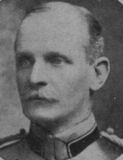
Sydney Gant, Private, 36219, Leicestershire Regiment. Sydney was the son of William Henry and Mary Anne Gant of Coningsby, Lincs. He married Lizzie Franklin, at Horncastle in 1911, and over the next four years the couple had four children. Sydney then brought his family to live at The Lodge, Abergwynant Hall, Dolgellau just prior to the war, after gaining work as a gardener on the estate. Sydney enlisted at Leeds into the West Yorkshire Regiment in 1915, and after completing his training was posted to France, joining the 9th Battalion, Leicestershire Regiment, which was attached to 110 Brigade, 21st Division. The Division moved to the Somme in 1916, and fought throughout the Somme offensive, capturing Gueudecourt before taking part in the Battle of Le Transloy. In March 1917 the Division followed the German Retreat to the Hindenburg Line, and in April fought during the Battle of Arras, seeing heavy fighting at Bullecourt. Later in 1917 the Division moved to Ypres, and the 9th Leicester’s relieved the 32nd Battalion, Australian Infantry at Polygon Wood on 30 September. At 05.25 the following morning, 1 October 1917, the battalion was hit by a heavy artillery barrage, and then smoke shells, and through the smoke screen waves of German infantry advanced, hitting the line held by the battalion minutes later and the right flank broke. The battalion counter-attacked to regain the flank, and terrible fighting raged throughout the morning. Sydney was killed in action at some time during the day. The 31-year-old has no known grave and is commemorated on the Tyne Cot Memorial, Belgium.
Dafydd Griffith, Private, 26874, King’s Own Shropshire Light Infantry. Dafydd was the son of David and Elizabeth Griffith of Glan Wnion, Dolgellau. He worked as a Draper, and enlisted at Denbigh into the Denbighshire Yeomanry soon after the outbreak of war. Dafydd was posted to France in the summer of 1916, joining the 7th Battalion, Kings Own Shropshire Light Infantry, which was attached to 76 Brigade, 3rd Division. The Division took part in terrible fighting during the Somme offensive that summer, especially during the horrific fighting in Delville Wood. The Division then took part in the Battle of the Ancre before settling into a bleak winter in France. By May 1917 the Division was at Arras, and fought at the First and Second Battles of the Scarpe, and then at the Battle of Arleux and the Third Battle of the Scarpe, where the Division famously captured Roeux. The Division was then transferred to Ypres during the middle of September, to take part in the great offensive towards Passchendaele Ridge. After training at Brandhoek, the 7th KSLI moved into the front line on 25 September, in readiness to launch an assault near Polygon Wood the following morning. The battalion followed up the initial assault by the 8th East Yorks, before moving through them and carrying on the attack towards the German second line, before digging in and consolidating. Dafydd was killed in action during the heavy fighting that day, 26 September 1917. The 27-year-old has no known grave and is commemorated on the Tyne Cot Memorial, Belgium. His brother Griffith was killed seven months later.
Griffith David Griffith, Corporal, 266096, South Lancashire Regiment. Griffith was the son of David and Elizabeth Griffith of Glan Wnion, Dolgellau. He worked as a Draper in London prior to returning to Wales and enlisting into the 2/7th Battalion, Royal Welsh Fusiliers at Newtown on 29 September 1914. Griffith spent most of the war on home service, but following the launching of the German Spring offensive on 21 March 1918, the British lost so many men that large numbers of troops which were being held back were sent out to the front. On 2 April 1918 Griffith embarked for France, and on 6 April 1918 joined the 2nd Battalion, South Lancashire Regiment. The battalion was attached to 75 Brigade, 25th Division and was in reserve at Ploegsteert. The Division had taken part in heavy fighting following the offensive of 21 March and by 1 April had been relieved and moved north to Belgium. On 2 April the Division took over a section of line near Ploegsteert. On 9 April 1918 the Germans launched the second phase of their great offensive along the Lys valley, and on the following day the 2nd South Lancs received news of the attack and moved to positions west of Ploegsteert, where the battalion came into contact with the Germans. Fighting raged again over the coming days as the Division was slowly pushed back, and by 14 April 1918 had reached Ravelsberg. Griffith was posted as missing during the withdrawal that day, and was later adjudged to have been killed in action. The 32-year-old has no known grave and is commemorated on the Ploegsteert Memorial, Belgium. His brother Dafydd had been killed seven months earlier.
James Griffith, Private, 3900, Royal Welsh Fusiliers. James was the son of Morris and Margaret Griffith, of Ochyryfoel Ucha, Llanfachreth. He worked as a farm labourer prior to enlisting at Dolgellau into the 3/7th Battalion, Royal Welsh Fusiliers soon after the outbreak of war. James was posted to Park Hall, Oswestry for training, but soon took ill, and was sent to Chester Isolation Hospital. He died there on 27 February 1916, aged 17. His remains were brought home for burial in St. Machreth Churchyard, Llanfachreth.
Watcyn Emil Owen Griffith, Private, 26402, Royal Welsh Fusiliers. Watcyn was born at Bangor in 1897, the son of John and Dora Griffith. By 1911 his father had taken over the position of Headmaster at Dolgellau County School, and the family was residing at the School House. Watcyn was a student when he enlisted into the Royal Welsh Fusiliers on 26 July 1915, and was sent to Llandudno, joining the 17th Battalion, Royal Welsh Fusiliers, which was attached to 115 Brigade, 38th (Welsh) Division. The Division moved to Winchester soon afterwards to complete its training. The Division moved to France on 2 December 1915 and moved to the Nursery Sector near Fleurbaix for trench initiation alongside the Guards Division. The Division then held a sector of the line near Cuinchy before marching south to the Somme sector in June 1916 to take part in the assault on Mametz Wood. The first attack on the wood was launched on a two-battalion front on 7 July, but failed, and the Divisional Commander, Sir Ivor Philipps, was replaced before the Division attacked again on a two Brigade front on 10 July 1916. Watcyn volunteered to be a runner, and his eldest brother, Captain Llewelyn Wyn Griffith, a Staff Officer with the Division. At the height of the fighting on 10 July Llewelyn was trying to get a message back to Divisional HQ at Pommiers Redoubt, but the telephone line was down, so a runner was sent instead. The runner was, unknown to Llewelyn, his brother Watcyn. Sadly, Watcyn was killed taking the message back from the advanced HQ to Pommiers Redoubt. Llewelyn wrote about the incident in his book: ‘Up to Mametz’. Watcyn was 21-years-old, and is commemorated on the Thiepval Memorial, France.
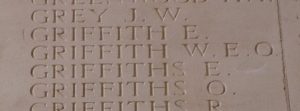
Robert William Griffiths, Private, 60263, Welsh Regiment. Robert was the son of David and Elizabeth Griffiths, of 2, Penybont, Rhydymain, Dolgellau. He worked as a Farm Labourer prior to enlisting at Wrexham into the 3rd Battalion, Welsh Regiment on 11 June 1917. Upon completing his training at Redcar, Robert embarked at Southampton for France on 6 November 1917, and was posted to the 5th Infantry Base Depot at Rouen. Robert was initially pencilled in to join the 17th Battalion, Welsh Regiment, but on 5 December 1917 joined the 9th Battalion, Welsh Regiment, which was attached to 58 Brigade, 19th (Western) Division, and joined the battalion just prior to the Divisions move to the Havrincourt Sector. The Division took over a section of the Flesquières Salient, and enjoyed a relatively few weeks in its new positions. Robert was killed in action here on 20 December 1917, aged 20. He has no known grave and is commemorated on the Thiepval Memorial, France.
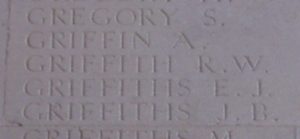
William John Griffith, Private, 39515, Royal Welsh Fusiliers. William was the son of Henry Hugh Griffiths and Kate Griffiths, of 3, Talyrafon Buildings, Dolgellau. He worked as a Painter with his father prior to enlisting at Dolgellau into the Royal Welsh Fusiliers on 1 January 1916, and was posted to the 20th (Reserve) Battalion, Royal Welsh Fusiliers at Kinmel Park for training. On 27 August 1916 William was posted to the 3rd Battalion, Royal Welsh Fusiliers, at Litherland Camp, and on 26 July 1917 embarked for France, joining No 5 Infantry Base Depot at Rouen. On 24 August 1917 William was posted to the 14th Battalion, Royal Welsh Fusiliers, which was at Ypres attached to 113 Brigade, 38th (Welsh) Division. The Division had taken part in its famous assault on the Pilckem Ridge on 31 July 1917, and remained in the line during the ensuing Battle of Langemarck. On 29 August the 14th RWF relieved the 17th RWF in the front line facing Langemarck, and began carrying out patrols to attempt to discover the exact locations and strengths of the Germans opposite. On 1 September Battalion HQ was hit by a shell and set alight. The officers and men evacuated it, doused the fire and went back in, then a shell inside HQ exploded, bringing the roof down on the men. The survivors were pulled out, then the battalion was relieved, moving back to a ruined house near Iron Cross. William was killed whilst working with a salvage party the following day, 2 September 1917. The 19-year-old has no known grave and is commemorated on the Tyne Cot Memorial, Belgium.
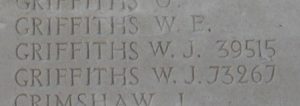
Frederick William Harness, Private, 76278, Tank Corps. Frederick was the son of Frederick William and Elizabeth Harness of Rose Cottage, Wainfleet, Lincolnshire. He came to Dolgellau to work as a gardener prior to the war. Frederick enlisted at Dolgellau into the Royal Welsh Fusiliers soon after the outbreak of war. Frederick was then posted to the 25th Division Cyclist Company, landing in France with the unit on 26 September 1915. The Division initially moved to the Ploegsteert sector for trench initiation, then spent much of February in Strazeele. By April the Division was in the Neuville-Saint-Vaast area and defended Vimy Ridge against a German attack in May 1916. The Division then moved to the Warloy area and attacked on 3 July near Thiepval. Frederick volunteered to serve with the newly formed Tank Corps at some time afterwards. Tanks had first seen action during the Battle of Flers in September 1916, as part of the Heavy Branch Machine Gun Corps and saw further action during the Somme offensive that summer. During November 1916 D Battalion was formed from the old D Company, and joined the 1st Tank Brigade alongside C Battalion. It’s first action under this new title was at Arras on 9 April 1917, under command of the 51st (Highland) Division, in an action which saw many tanks become bogged down in soft ground, but still saw four D Battalion tanks help capture the village of Neuville-Vitasse and the attack on Telegraph Hill. On 11 April 1917, four tanks of D Battalion were in action south of Monchy, supporting an infantry assault on the Hindenburg Line, and managed to push into Wancourt, a mile beyond the line, before being forced to retreat as the infantry had not moved forward. Frederick was killed in action here during the days fighting. The 24-year-old has no known grave and is commemorated on the Arras Memorial, France.
Evan Edward Hughes, Private, 3410, Royal Welsh Fusiliers. Evan was the son of Mrs. Mary Williams of 4, Cader Road, Dolgellau. He was raised at the Union Workhouse, at Dolgellau and worked at the Royal Ship Hotel, Dolgellau prior to the war. Evan enlisted at Dolgellau into the 7th Battalion, Royal Welsh Fusiliers. The battalion was a Territorial unit, which mobilised for war at Newtown in August 1914, as part of North Wales Brigade, Welsh Division and moved to Conway until the end of the month, before moving to Northampton. In December the Division moved to Cambridge and then in May 1915 to Bedford, where the Division was numbered and the formation became 158 Brigade, 53rd (Welsh) Division. On 19 July 1915 the entire Division sailed from Devonport for Imbros and on 9 August 1915 landed at Suvla Bay. The infantry moved off the beaches into the bush, but due to a lack of maps and no knowledge of the terrain, many of the units became disorientated, and the situation became chaotic. Evan was killed in action during heavy fighting the following day, 10 August 1915, aged 22. He has no known grave and is commemorated on the Helles Memorial, Gallipoli.
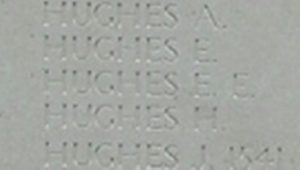
William Hughes, Private, 5940, Royal Welsh Fusiliers. William was born in Rhydymain in 1874, the son of Hugh and Catherine Hughes. He married Mary Alice Roberts on 7 May 1904, and the couple lived at 17, English Terrace, Dolgellau. He was an Army Reservist, and had been working as a coal miner prior to re-enlisting at Warrington into the 3rd Battalion, Royal Welsh Fusiliers on 30 August 1914 and travelled to the Depot at Wrexham. On 11 November 1914 William landed in France, after being drafted to the 1st Battalion, Royal Welsh Fusiliers, which was in the Ypres Salient, attached to 22 Brigade, 7th Division. The Division had landed at Zeebrugge on 6 October 1914, but the City was falling to the Germans, so the Division moved to Ypres, becoming the first British Division to hold the city. The Division took part in heavy fighting during the First Battle of Ypres, and helped stop the German advance through Belgium towards the Channel coast. William joined the battalion at Merris, where it was rebuilding following its efforts at Ypres. On 14 November the battalion received orders to take over trenches at Touquet, just south of Bois-Grenier, and that day began a long spell in the new line. William was killed in action here on 9 December 1914, aged 40. He has no known grave and is commemorated on the Ploegsteert Memorial, Belgium.
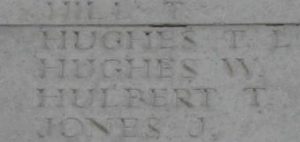
Hugh Thomas Humphreys, Gunner, 137649, Royal Garrison Artillery. Hugh was the son of John and Jane Humphreys, of Well Street, Dolgellau. He worked in Llanwonno around the turn of the century, and married Lilian Hemlin in 1904, before the couple moved to her native Portsea, where Hugh found work as a Leather Dresser. He had served at some time with the 4th Battalion, Royal Welsh Fusiliers so, probably to earn extra money, Hugh enlisted at Portsea into the Hampshire Battery, Royal Garrison Artillery on 10 February 1913. The battery was a Territorial unit, which helped guard the Portsmouth RN Dockyards. Following the outbreak of war, Hugh signed up for overseas service, and after spending almost three years with the 44th Anti-Aircraft Company at Portsmouth was posted out to the Persian Gulf with the 59th Anti-Aircraft Section, Royal Garrison Artillery. Hugh had only been in the Gulf for 6 months, when he took ill and died of pneumonia on 15 March 1918, aged 36. He is buried in Baghdad (North Gate) War Cemetery, Iraq. His brother, John, had been killed in 1915.
John Humphreys, Private, 6037, Royal Welsh Fusiliers. John was the son of John and Jane Humphreys, of Well Street, Dolgellau. He was an Army Reservist, and had spent 9 years with the 2nd Battalion, Royal Welsh Fusiliers before finding work as a Collier. John re-enlisted at Wrexham into the 3rd Battalion, Royal Welsh Fusiliers on 1 September 1914. On 11 November 1914 William landed in France, after being drafted to the 1st Battalion, Royal Welsh Fusiliers, which was in the Ypres Salient, attached to 22 Brigade, 7th Division. The Division had landed at Zeebrugge on 6 October 1914, but the City was falling to the Germans, so the Division moved to Ypres, becoming the first British Division to hold the city. The Division took part in heavy fighting during the First Battle of Ypres, and helped stop the German advance through Belgium towards the Channel coast. William joined the battalion at Merris, where it was rebuilding following its efforts at Ypres. On 14 November the battalion received orders to take over trenches at Touquet, just south of Bois-Grenier, and that day began a long spell in the new line. It was here that John saw the death of his friend, and fellow Dolgellau man, William Hughes, on 9 December. The Division remained in the same area over the coming months, taking part in the Battle of Aubers Ridge on 9 May 1915. The following week, on 15 May, the Battle of Festubert was launched. The 7th Division was in reserve on the opening day, but on 16 May 1915 moved up to take part in the fighting. The 1st RWF was ordered to assault the German trenches on a 200-yard front between Rue Quinque and Rue Ouvert and at 02.45 launched its assault, the men going forwards in waves after using scaling ladders to go over the parapets of the trenches, but soon met with heavy resistance. The German front line was taken, but heavy casualties had been suffered taking the second line, towards La Quinque Rue. John had been badly wounded during the assault that morning, and died that same day. The 42-year-old has no known grave and is commemorated on the Le Touret Memorial, Richebourg L’Avoue, France. His brother, Hugh, died in the Persian Gulf in 1918.
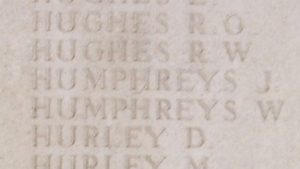
John Robert Humphreys, Private, 39079, Royal Welsh Fusiliers. John was the son of John and Mary Anne Humphreys of 3, Park Row, Dolgellau. He was a schoolteacher for almost ten years prior to becoming a student at Hull Training College prior to the war. John enlisted there into the Royal Welsh Fusiliers on 12 December 1915, where he was categorised as Class B, not fit for front line service, and placed on the Army Reserve. On 1 March 1916 he was mobilised and travelled to the Barracks at Wrexham, and two days later joined the 21st Battalion, Royal Welsh Fusiliers at Kinmel Park. Even though the military were aware that John was suffering from tuberculosis, he was accepted into the infantry and began training at Kinmel. Within weeks his health had deteriorated, and he was brought to the Military Hospital at Bangor where he died of tuberculosis on 19 April 1916, aged 29. His remains were brought home for burial in Dolgellau Nonconformist Cemetery.
Robert Humphreys, Corporal, 59522, The King’s (Liverpool Regiment). Robert was the son of Morris and Catherine Humphreys, of South Street, Dolgellau. He worked as a Barber in Liverpool prior to the war, and lived at 11, Ludwig Road, Anfield. Robert enlisted at Seaforth into the King’s (Liverpool Regiment), and after completing his training, was posted to France, joining the 4th Battalion, The King’s (Liverpool Regiment), which was attached to 98 Brigade, 33rd Division. Robert probably joined the battalion in the Ypres Salient during the late summer of 1917, possibly in time to take part in the Battles of the Menin Road and at Polygon Wood. The Division was still in Flanders when the German Spring Offensive hit on 9 April 1918, and saw heavy fighting as it was pushed back towards Neuve Eglise. The Division then took part in the First Battle of Kemmel, and recaptured Ridge Wood, before being sent to the area north of St. Quentin in September to take part in the great offensive, which had been launched on 21 August. By 16 September Robert’s battalion had moved to Lesboeufs, and four days later moved into trenches in front of Villers Guislain. Robert was among six men killed in action by a German shell whilst the battalion was holding the trenches here on 20 September 1918. The 32-year-old has no known grave and is commemorated on the Vis-en-Artois Memorial, France.
John Richard James, Private, 35441, Royal Welsh Fusiliers. John was the son of Richard and Anne James, of Rhydymain, Dolgellau. He lived at Waltham Abbey prior to the war, and worked as a machine turner. John enlisted at Holborn, London into the Royal Welsh Fusiliers on 8 December 1915, and was posted to the 18th Battalion, Royal Welsh Fusiliers, which was the 2nd London Welsh Battalion, at Kinmel Park. On 25 July 1916 John embarked for France, initially bound for the 19th Battalion, Royal Welsh Fusiliers, but was instead posted to the 10th Battalion, Royal Welsh Fusiliers, which was on the Somme attached to 76 Brigade, 3rd Division. John joined the battalion in camp at Mericourt, after its epic fight at Delville Wood, where two men of the battalion had been awarded Victoria Crosses. On 15 August the 10th RWF moved back into the front line near Talus Bois, taking over positions at Casement, Dublin and Chimpanzee Trenches and on the following day took part in an attack against the German positions at Lonely Trench. During the heavy fighting over the coming days the battalion suffered almost 350 casualties, and was withdrawn, moving back into reserve near Morlancourt before moving to Candas. The Division then moved to the area around Noeux-Les-Mines for a short while, before returning to the Somme, to take part in the Battle of the Ancre. In the meantime, John had spent a month in hospital after injuring his knee, but re-joined the battalion on 12 November, in the trenches at Serre. On the following day the battalion took part in another assault, attacking the German lines at Serre, but again suffered heavily, with almost 300 casualties during the day. The line then quietened down, and a relatively peaceful spell of routine trench warfare followed. John was one of three men of the 10th RWF killed in action in the Serre trenches on 28 November 1916. The 23-year-old is buried in Euston Road Cemetery, Colincamps, France. His brother William, in the same battalion, had been killed on the Somme on 16 August.
William Evan James, Lance Corporal, 35371, Royal Welsh Fusiliers. William was the son of Richard and Anne James, of Rhydymain, Dolgellau. He worked as a milkman in London prior to the war and lived at 11, Downham Road, Kingsland. William enlisted at Holborn, London into the Royal Welsh Fusiliers on 17 January 1916, and was posted to the 18th Battalion, Royal Welsh Fusiliers, which was the 2nd London Welsh Battalion, at Kinmel Park. On 23 July 1916 William embarked for France, initially bound for the 19th Battalion, Royal Welsh Fusiliers, but was instead posted to the 10th Battalion, Royal Welsh Fusiliers, which was on the Somme attached to 76 Brigade, 3rd Division. William joined the battalion in camp at Mericourt, after its epic fight at Delville Wood, where two men of the battalion had been awarded Victoria Crosses. On 15 August the 10th RWF moved back into the front line near Talus Bois, taking over positions at Casement, Dublin and Chimpanzee Trenches and on the following day took part in an attack against the German positions at Lonely Trench. William was killed in action during the terrible fighting at Lonely Trench on 16 August 1916. The 21-year-old is buried in Guillemont Road Cemetery, Guillemont, France. His brother John, in the same battalion, was killed at Serre on 18 November.
Isaac Lewis Jenkins, Drummer, 16425, Welsh Regiment. Isaac was born at Tywyn on 10 June 1891, the son of Evan and Sarah Jenkins. The family later moved to 12, St. David Street, Llanelli, and Isaac met and married Kate E. Griffiths at Llanelli in June 1911. The couple then moved back to North Wales, and lived at 6, Union Square, Dolgellau. Isaac enlisted soon after the outbreak of war into the 10th Battalion, Welsh Regiment. The battalion was raised in the Rhondda Valley by D. Watts Morgan, M.P. in September 1914, originally moving to Codford St. Mary to join 76 Brigade, 25th Division. At the end of September, it was sent to North Wales to join the other locally raised units in 129 Brigade, 43rd (Welsh) Division at Rhyl. On 29 April 1915 the formation was renumbered 114 Brigade, 38th (Welsh) Division, moving to Winchester to complete its training. The Division moved to France on 2 December 1915 and moved to the Nursery Sector near Fleurbaix for trench initiation alongside the Guards Division. The Division then held a sector of the line near Cuinchy before marching south to the Somme sector in June 1916 to take part in the assault on Mametz Wood. The first attack on the wood was launched on a two-battalion front on 7 July, but failed, and the Divisional Commander, Sir Ivor Philipps, was replaced before the Division attacked again on a two Brigade front on 10 July 1916. Isaac was killed during the latter stages of the capture of the wood, on 12 July 1916. The 27-year-old has no known grave, and is commemorated on the Thiepval Memorial, France.
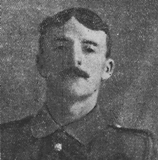
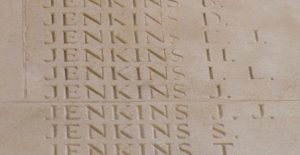
Abraham Jones, 2nd Corporal, 121728, Royal Engineers. Abraham was the son of Cadwaladr and Jane Jones of Arran Road, Dolgellau. By 1901 he was lodging at Meirion Cottage, Blaenau Ffestiniog, where he worked as a slate quarrier, and he married Annie Ellen Griffiths there in the spring of 1901. Over the coming years, Annie gave birth to four sons at Blaenau Ffestiniog. Abraham enlisted into the Royal Engineers following the outbreak of war, and as a skilled worker, was posted to the 183rd Tunnelling Company, Royal Engineers. The Company had been formed at Rouen in October 1915, and moved to Carnoy to prepare mines and saps for the forthcoming Somme offensive, and the Company dug four mines in the Mametz area, as well as digging numerous Russian saps, four of which were equipped with Livens Flame Projectors. The Company then moved to the Messines sector and began work on deep dugouts and mines in preparation for an offensive on the Messines Ridge the following year. The Battle of Messines was launched on 7 June 1917, and was heralded by the blowing of a series of 19 mines under the German lines, stunning the survivors before waves of infantry attacked, supported by tanks. Many of these craters still survive today. Abraham was wounded during the latter stages of the battle, and died of his wounds at the 61st Casualty Clearing Station, Belgium on 20 July 1917, aged 35. He is buried in Dozinghem Military Cemetery, Belgium.
David Jones, Private, 25546, Royal Welsh Fusiliers. David was the son of Edward and Margaret Jones, of Penrhos Isaf, Llanfachreth. He worked as a labourer prior to enlisting at Bala into the 17th Battalion, Royal Welsh Fusiliers on 27 February 1915. He was posted to Llandudno where the battalion was training as part of the newly formed 128 Brigade, 43rd (Welsh) Division. On 29 April 1915 the formation became 113 Brigade, 38th (Welsh) Division, and moved to Winchester to complete its training before moving to France on 4 December 1915. The Division then moved to the Nursery Sector near Fleurbaix for trench initiation alongside the Guards Division. The Division then took over a section of line near Cuinchy, in terrible conditions, where it remained over the coming months. By 23 June 1916 the conditions had taken their toll on David’s health, and he was admitted to the 130th Field Ambulance suffering from bronchitis. He was posted to Rouen, where he became ill again and was treated in hospital in Le Treport. Upon his recovery, he was posted to the 2nd Battalion, Royal Welsh Fusiliers, reaching the battalion on the Somme on 27 July 1916, where it was attached to 19 Brigade, 33rd Division. The Division fought throughout the Somme offensive, and by the beginning of November 1916 was in the line near Lesboeufs. Over the coming days the battalion carried out a number of raids and made an assault in support of a French attack, in dire conditions, and on the night of 7 November was relieved, marching back to La Briqueterie, then to Méaulte, where the Prince of Wales visited. David was found to be missing during the battalion roll call here, and was later found to have been captured by the Germans in the last torrid spell in the line. He was taken to a camp near Cambrai, but his health again broke down and he died at the Cambrai POW Hospital on 7 February 1917, aged 21. David was originally buried in Hendecourt-les-Cagnicourt, but the graves there were lost during fighting later in the war, so he is now commemorated on a Special Memorial within Croisilles British Cemetery, France.
David Pugh Jones, Private, 11677, New Zealand Expeditionary Force. David was born on 26 March 1887, the son of Richard and Jane Jones, of Dolfawr, Dolgellau. He worked as a gold miner prior to emigrating to New Zealand and found work as a labourer at Upton Falls, Awatere. David enlisted into the New Zealand Expeditionary Force at Trentham, Wellington, on 12 January 1916 and was posted to C Company, 12th Reinforcements. David left New Zealand with the 12th Reinforcements in May 1916 and arrived in Egypt in July, before embarking for Southampton. On 22 September 1916 David was posted to France, joining the 1st Battalion, Canterbury Regiment. In May 1917 David spent several days attached to the Canadian Engineers, and then to the New Zealand Engineers, being put to work on Tunnelling duties in the Ypres Salient, in readiness for the Battle of Messines. He re-joined his battalion at Ypres on 7 October, after being home on two weeks leave. The New Zealand Division, attached to II Anzac Corps, was preparing to launch an assault on the Passchendaele Ridge. On 12 October 1917 the Anzacs launched their attack, but the 1st Canterbury’s found themselves unable to get through the German barbed wire. The Germans held a strong defensive line, with numerous concrete emplacements, and raked the troops with merciless machine-gun fire. David was killed in action during the attack that day. The 30-year-old has no known grave and is commemorated on the Tyne Cot Memorial, Belgium.
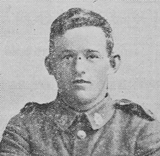
Edward Jones, Private, 42533, Suffolk Regiment. Edward, known as Teddy, was the son of William and Caroline Jones, of 8, Arran Road, Dolgellau. He enlisted at Dolgellau into the Army Cyclist Corps, and was posted to France in the spring of 1918, where he was transferred to the 2nd Battalion, Suffolk Regiment. The battalion was attached to 76 Brigade, 3rd Division. The battalion had suffered heavy casualties when the Division was caught up in the heavy fighting which followed the German Spring Offensive of 21 March 1918. The Division had then been moved north to Flanders to rebuild, but became caught up in the second phase of the German offensive, on the Lys, from 9 April. The Division saw more heavy fighting as it took part in the withdrawal towards Bethune over the coming days, before the Allies counter-attacked, and the Germans switched their attention to the Aisne sector. The Division moved to the Somme sector later in the summer to take part in the great offensive, which had been launched on 21 August. Edward was killed in action soon afterwards, during fighting north of Bapaume on 30 August 1918. The body of the 19-year-old was found in a captured village, and buried by a burial party from his battalion in Écoust-St. Mein British Cemetery, France.
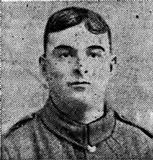
Evan Jones, Private, 11027, Royal Welsh Fusiliers. Evan was the son of Alice Jones, of 2, Park Lane, Dolgellau. He worked as a farm labourer prior to enlisting at Wrexham into the 1st Battalion, Royal Welsh Fusiliers some time before the war. The battalion was at Malta when the Germans invaded France and Belgium, and sailed for England, joining 22 Brigade, 7th Division at Lyndhurst. On 7 October 1914 Evan landed with the battalion at Zeebrugge. The Division was astounded to find that the city was already in the process of falling to the Germans, so it moved to defend the city of Ypres, being the first British Division to take up its defences. The Division saw heavy fighting during the First Battle of Ypres, helping stop the German advance through Belgium to the Channel coast. The battered battalion then moved to Merris, to rest and rebuild following its efforts at Ypres. On 14 November the battalion received orders to take over trenches at Touquet, just south of Bois-Grenier, and that day began a long spell in the new line. The Division remained in the same area over the coming months, taking part in the Battle of Aubers Ridge on 9 May 1915. The following week, on 15 May, the Battle of Festubert was launched. The 7th Division was in reserve on the opening day, but on 16 May 1915 moved up to take part in the fighting. The 1st RWF was ordered to assault the German trenches on a 200-yard front between Rue Quinque and Rue Ouvert and at 02.45 launched its assault, the men going forwards in waves after using scaling ladders to go over the parapets of the trenches, but soon met with heavy resistance. The German front line was taken, but heavy casualties had been suffered taking the second line, towards La Quinque Rue. Evan had been badly wounded at Festubert, and was evacuated to No 4 Casualty Clearing Station at Lillers where he died of his wounds on 17 May 1915, aged 23. He is buried in Lillers Communal Cemetery, France.
Eynon Llewellyn Jones, Sub Lieutenant, Royal Navy. Eynon was born at Ventnor, Isle of Wight, on 30 September 1893, the son of Evan Jones and Frances Beatrice Jones (nee Phillips). His parents later resided at Derwen House, Dolgellau. Eynon had joined the Royal Naval Reserve as a young man, and was promoted to Sub Lieutenant on 13 May 1915 from the position of Acting Sub Lieutenant. By now, Eynon was based in Edinburgh, and was serving aboard the Battlecruiser HMS Indefatigable. She was moored at Edinburgh where she was attached to the 2nd Battle Cruiser Squadron, which was commanded by Rear Admiral Packenham, and was part of Sir David Beatty’s Battlecruiser Fleet. The Fleet had put to sea following intelligence reports of the German High Seas Fleet being in the North Sea, and steamed at full speed to engage the Germans in the North Sea off Jutland. The two forces met at around 15.30 and Beatty turned his fleet to the south, to gain time before the main Grand Fleet, commanded by Sir John Jellicoe and steaming from Northern Scotland and Scapa Flow, could enter the fight. At 15.48 the Germans opened fire, followed by the British, and twelve minutes later a salvo of German shells struck HMS Indefatigable, igniting her magazines and blowing the doomed ship apart. Only three of the crew of 1,019 survived. Eynon was 23 years old when he was killed in the sudden explosion that day, and is commemorated on the Plymouth Naval Memorial, Devon.
George Jones, Lance Sergeant, 2620, Royal Welsh Fusiliers. George was the son of William and Elizabeth Jones, of Arran Road, Dolgellau. He worked as a Tanner with his father prior to the war. George enlisted at Dolgellau into the 7th Battalion, Royal Welsh Fusiliers. The battalion was a Territorial unit, which mobilised for war at Newtown in August 1914, as part of North Wales Brigade, Welsh Division and moved to Conway until the end of the month, before moving to Northampton. In December the Division moved to Cambridge and then in May 1915 to Bedford, where the Division was numbered and the formation became 158 Brigade, 53rd (Welsh) Division. On 19 July 1915 the entire Division sailed from Devonport for Imbros and on 9 August 1915 landed at Suvla Bay. The infantry moved off the beaches into the bush, but due to a lack of maps and no knowledge of the terrain, many of the units became disorientated, and the situation became chaotic. George was killed in action during heavy fighting the following day, on 10 August 1915, aged 21. He has no known grave and is commemorated on the Helles Memorial, Gallipoli.
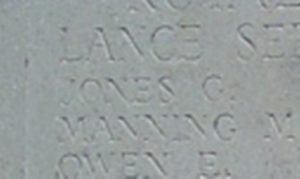
Henry Jones, Private, 2742, Royal Welsh Fusiliers. Henry was born on 24 October 1879, the son of John and Gwen Jones, of English Terrace, Dolgellau. He married Lizzie Gwen Evans, of Dolgellau, on 17 December 1898. Henry had served in the Boer War, and upon his return moved his family to South Wales, where he worked as a collier. By 1911 the family had returned home, and lived at 3, Plasbrith Lane, Dolgellau, where Henry worked as a Tanner. He continued to serve with the 7th Battalion, Royal Welsh Fusiliers between the wars. The battalion was a Territorial unit, which mobilised for war at Newtown in August 1914, as part of North Wales Brigade, Welsh Division and moved to Conway until the end of the month, before moving to Northampton. In December the Division moved to Cambridge and then in May 1915 to Bedford, where the Division was numbered and the formation became 158 Brigade, 53rd (Welsh) Division. On 19 July 1915 the entire Division sailed from Devonport for Imbros and on 9 August 1915 landed at Suvla Bay. The infantry moved off the beaches into the bush, but due to a lack of maps and no knowledge of the terrain, many of the units became disorientated, and the situation became chaotic. Henry was killed in action during heavy fighting on the following day, 10 August 1915, aged 36. He has no known grave and is commemorated on the Helles Memorial, Gallipoli. His brother-in-law, William Lewis Evans, was killed alongside him.
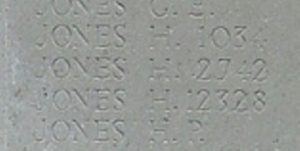
John H. Jones, Private, 23413, Royal Welsh Fusiliers. John was born at Llansawel, the son of Evan and Ellen Jones. His parents later moved to Tynglanyrafon, Bontddu, where John and his father worked as goldminers. John later resided in Whitland and then at Cwmtwrch prior to the war, finding work as a coalminer. He enlisted at Carmarthen into the army and was posted to the 10th Battalion, Royal Welsh Fusiliers. The battalion was attached to 76 Brigade, 25th Division at Codford St. Mary, Salisbury Plain, where the men received their basic training, before moving to Romsey then Aldershot. On 27 September 1915 John landed in France with the battalion, and the Division assembled in the southern sector of the Ypres Salient. Two weeks later 76 Brigade transferred to the 3rd Division. The 10th Royal Welsh Fusiliers saw their first major action with the Division during the actions of the St. Eloi craters, south of Ypres, during March 1916. The action began when the British exploded six underground mines on 27 March, and rushed forward, capturing four of them, thus extending their front line. John was badly wounded by gunshot wounds to his buttocks during the ensuing fighting, and was brought to the No. 13 General Hospital at Boulogne on 1 April 1916. He died there of his wounds on 4 April 1916, aged 29, and is buried in Boulogne Eastern Cemetery, France.
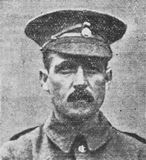
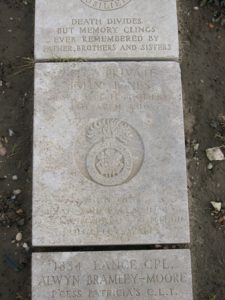
John Hugh Jones, Private, 49882, Royal Welsh Fusiliers. John was the son of Hugh and Jane Jones of Ty Newydd, South Street, Dolgellau. He lived and worked in Liverpool prior to enlisting there into the Royal Welsh Fusiliers. John was then posted to Kinmel Park for training before embarking for France in the summer of 1917 to join the 13th Battalion, Royal Welsh Fusiliers, which was attached to 113 Brigade, 38th (Welsh) Division. He probably joined the battalion at the Canal Bank sector north of Ypres, in time to take part in the Divisions assault on the Pilckem Ridge on 31 July 1917. The Division took part in the ensuing Battle of Langemarck, before being relieved and moving to positions in the Lys valley, near Armentieres for the winter. At the end of March 1918, the Division was rushed south to the Somme, relieving the battered 2nd and 47th Divisions in the line north of Albert, facing Bouzincourt Ridge, and carried out a series of small operations over the coming weeks to gain the high ground overlooking the Ancre valley. On 21 August 1918 the Division began to cross the flooded Ancre valley and assaulted Thiepval and Pozieres Ridges, before beginning to advance across the old Somme battlefields of 1916. John was wounded during his battalions’ assault on Bazentin-le-Grand Wood and village on 26 August, and died of his wounds at the 34th Casualty Clearing Station, Fienvillers on the following day, 27 August 1918, aged 19. He is buried in Fienvillers British Cemetery, France.
Lewis Jones, Private, 1712, Welsh Guards. Lewis was the son of John and Jane Jones of Esgeiriau, Rhydymain. He worked as a farm labourer prior to enlisting at Northampton into the 1st Battalion, Welsh Guards. The Regiment was raised by Royal Warrant of 26 February 1915, at White City, before landing at Le Havre on 18 August 1915, becoming attached to 3rd Guards Brigade, Guards Division. The Division saw its first major action during the Battle of Loos, which began on 25 September 1915, remaining in the area during the coming months, where they also fought in the subsequent Action of Hohenzollern Redoubt. Lewis joined the battalion after the Loos offensive, prior to the Guards move south to the Somme. The Guards Division then took part in the Battle of Flers-Courcelette, which was the first time that tanks were used in action. The Division then took part in the Battle of Morval, capturing the German held village of Lesboeufs. Lewis was badly wounded during the Somme offensive, and reportedly lay in No Man’s Land for a long time before being rescued by a stretcher bearer crew. He spent many months in hospitals, having an arm amputated, before returning home, where he eventually died of his wounds on 29 May 1917, aged 21. Lewis is buried in Rhydymain Independent Chapelyard.
Morris Jones, Private, 52043, Cheshire Regiment. Morris was the son of William and Margaret Jones, of Clywedog, Dolgellau. He lived at Bryn Deri, Abercrave, and worked as a coalminer prior to the war. He then gained work in a Munitions Factory in Middlesex, and lodged there for several months before enlisting at Uxbridge into the Royal Welsh Fusiliers on 11 December 1915. He was initially placed on the Army Reserve, but was mobilised at Hounslow on 18 March 1916, joining the 3rd Battalion, Royal Welsh Fusiliers at Litherland Camp, Liverpool. On 4 July 1916 Morris embarked for France, initially bound for the 1st Battalion, Royal Welsh Fusiliers, but on 4 September was transferred to the 13th Battalion, Cheshire Regiment, which was attached to 74 Brigade, 25th Division. The Division was on the Somme, so Morris would have seen his first action during the Somme offensive that year. The Division then moved to Ploegsteert in October 1916, and held the line for the months leading up the Battle of Messines in June 1917. The Division then had a brief rest before moving to the Railway Wood sector, at Ypres, at the end of July and took over the line at Westhoek Ridge on 1 August 1917. The trenches were in poor condition, devastated by shell-fire and waterlogged, so the Division endured a trying time there under continuous shell-fire. Morris was posted as missing on 10 August 1917, and was later deemed by a tribunal to have been killed in action on that date. The 28-year-old has no known grave and is commemorated on the Ypres (Menin Gate) Memorial, Belgium.
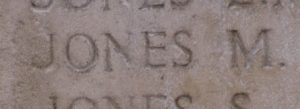
Owen Jones, Private, 2738, Welsh Guards. Owen was the son of John and Gwen Jones, of Ochryfoel Ucha, Llanfachreth. He enlisted at Dolgellau into the Welsh Guards and after completing his training, was posted to France, joining the 1st Battalion, Welsh Guards, which was attached to the Guards Division. He probably joined the battalion in the autumn of 1916, following its efforts during the Somme offensive that summer. Following the Battle of Morval, the Guards wintered on the Somme, and followed the German withdrawal to the Hindenburg Line the following year. The Division then went into a rest area at Péronne, then to St. Omer at the end of May 1917, where the Guards Division trained in readiness for the forthcoming Passchendaele offensive. The Guards Division moved into the line north of Pilckem, to the left of the 38th (Welsh) Division, and prepared for the offensive, which would be launched on 31 July. Less than two weeks prior to the offensive, the Welsh Guards was in the process of being relieved from a tour in the front line on 19 July 1917, when the battalion came under heavy German artillery fire. Owen was killed in the bombardment. He was 26 years old and is buried in Canada Farm Cemetery, Belgium.
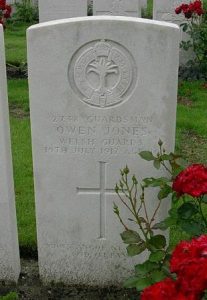
William Jones, Private, 3232, Royal Welsh Fusiliers. William was the son of Richard and Susannah Jones, of 4 Park Lane, Dolgellau. He worked as a labourer on the railways prior to the war. William enlisted at Dolgellau into the 7th Battalion, Royal Welsh Fusiliers. The battalion was a Territorial unit, which mobilised for war at Newtown in August 1914, as part of North Wales Brigade, Welsh Division and moved to Conway until the end of the month, before moving to Northampton. William’s health began to break down soon after the outbreak of war and he was discharged from the army as medically unfit on 1 January 1915. His health continued to deteriorate over the coming years, and William eventually died of tuberculosis at home on 15 November 1919, aged 31. He was buried four days later in St. Mary’s Churchyard Extension, Dolgellau. William is not commemorated as an official war casualty by the CWGC. His sister, Mrs Mary Elizabeth Smith, died on 21 August 1918 and is also commemorated on the memorial.
William Ellis Jones, Sergeant, W/298, Royal Field Artillery. William was born at Tanycoeden, Dolgellau in 1891, the son of Hugh and Jane Meredith Jones. By 1909 the family was residing at 19, Abergwawr Place, Aberaman, Aberdare, where William was working as a Coal Hewer. William enlisted at Aberdare into the Welsh Divisional Royal Field Artillery, and was posted to North Wales for training, before the entire 38th (Welsh) Division moved to Morn Hill Camp, Winchester to complete its training in the summer of 1915. By now William was serving with A Battery, 121st Brigade, Royal Field Artillery. The entire Division moved to France in December 1915, and spent its first winter in the trenches near Armentieres. In June the Division marched south to the Somme, tasked with the capture of Mametz Wood. The attack on the wood began on 7 July, but met with fierce resistance, and it took until 12 July to totally clear the wood. The Division suffered terrible casualties at Mametz, and was taken out of the line, and moved to the Canal Bank Sector, north of Ypres. On 31 July 1917 the Division launched its famous assault against the Pilckem Ridge, and attained its objectives by the end of the day. It remained in the line, and took part in the ensuing Battle of Langemarck. William was wounded at Elverdinghe on 9 September and was evacuated to a Casualty Clearing at Proven where he died of his wounds on the following day, 10 September 1917, aged 26. He is buried in Dozinghem Military Cemetery, Belgium.
William Hugh Jones, Private, 291318, Royal Welsh Fusiliers. William was born in Liverpool in 1896, the son of Hugh and Lizzie Jones. The family was living at Barmouth by 1902 and by 1911 had moved to 2, Talyrafon Buildings, Dolgellau, where William worked as a Butcher’s Messenger. William enlisted into the 7th Battalion, Royal Welsh Fusiliers after the outbreak of war, and was posted to France in 1917, joining the 10th Battalion, Royal Welsh Fusiliers, which was attached to 76 Brigade, 3rd Division. William joined the battalion in time to take part in the Battle of Arras, where the Division saw heavy fighting during the capture of the German held village of Roeux. William was wounded at Arras in July 1917, and after treatment in hospital in France returned to England for further treatment. He had, unfortunately, contracted tuberculosis, and his health deteriorated over the coming years. William eventually died of tuberculosis at home on 22 April 1920, aged 23. He is buried in Dolgellau Nonconformist Cemetery.
Joseph Kynaston, Private, 9144, Royal Welsh Fusiliers. Joseph was the illegitimate son of Mary Kynaston, of Nannau Lodge, Llanfachreth. His grandfather was the Gamekeeper on the Nannau Estate. He enlisted into the Royal Welsh Fusiliers Militia at Ffestiniog on 14 November 1904, and then enlisted at Wrexham into the 2nd Battalion, Royal Welsh Fusiliers on 7 July 1906, serving for several years at Quetta, India with the battalion. When war was declared the battalion was at Portland and on 11 August 1914 landed at Rouen as Line of Communications Troops. On 22 August 1914 the battalion joined 19 Brigade, at Valenciennes, and two months later, on 12 October 1914, the Brigade joined the 6th Division at Strazeele. Over the coming days the Division marched through Bailleul for Vlamertinghe, and on 20 October moved again to Laventie, before the 2nd RWF took over the line at La Boutillerie and La Cordonnerie Farm. Joseph was one of two men of the battalion killed by snipers in the line here on 23 October 1914. He was 30 years old, and is buried in Pont-du-Hem Military Cemetery, La Gorgue, France.
Edward Enfield Lawford, Lieutenant, Indian Army. Edward was born at Notting Hill on 10 July 1882, the son of Percy Lawford and Anne Lawford (née Aikin). By 1911 his parents had taken up residence at Borthwnog, Bontddu. He was educated at Bedales School and then studied mine engineering at Cambourne College. On 14 April 1905 Edward embarked at London aboard the SS Manora for Madras, and spent five years working at the Ooregum Gold Mine. He returned home in 1910 to visit his parents at Borthwnog, but in 1911 left for Ceylon. Edward was commissioned into the Indian Army in December 1914, and was posted to the 20th Deccans Horse. The battalion sailed for Europe in June 1915 attached to the Secunderabad Cavalry Brigade, 2nd Indian Cavalry Division. On 1 January 1917 the Secunderabad Cavalry Brigade became attached to the 5th Cavalry Division. On 13 June 1917 Edward’s battalion launched an assault on Ascension Wood, and encountered heavy resistance. Edward was last seen entering the wood, and was later judged to have been killed in action during the days fighting. The 34-year-old has no known grave and is commemorated on the Neuve-Chapelle Memorial, France.
Arthur Edward Lewis, Private, 116398, Canadian Machine Gun Corps. Arthur was born on 19 October 1872, the son of Reverend Evan Lewis and Adelaide Owen Lewis (nee Morrall). He was baptised at St. Mary’s, Dolgellau on 11 December 1872, where his father was the Rector. His father later became Dean of Bangor Cathedral and held the position until his death on 24 November 1901, when Arthur’s mother moved back to Clogwyn, Dolgellau. Arthur was educated at Ysgol Friars, Conwy and had served for a number of years with the 4th Battalion, Royal Welsh Fusiliers, prior to emigrating to Canada, finding work as a Teamster in Alaska. Arthur travelled to Canada and enlisted at Vernon, British Columbia into the 11th Canadian Mounted Rifles on 27 May 1915. Probably due to his age, Arthur was transferred to the Canadian Army Service Corps and embarked at Halifax aboard the SS Lapland on 8 July 1916, disembarking at Southampton two weeks later. He was sent to the Canadian Camp at Witley where he joined the 5th Canadian Divisional Train, but at his own request on 7 March 1918 transferred to the 2nd Battalion, Canadian Machine Gun Corps, joining the battalion in France on 28 March. He joined the battalion in the southern Somme Sector, and took part in the great combined Australian and Canadian victory at Villers-Bretonneux on 8 August 1918. The victory broke the spirit of the Germans, and on 21 August the Allies launched a large-scale offensive along the Western Front. Arthur’s battalion was supporting an attempt to seize crossings over the Sensée and L’Escaut Rivers when he was badly wounded, being shot in the leg and suffering a fractured thigh on 15 October. He was admitted into the 4th General Hospital at Camiers, but soon became seriously ill, and died of his wounds there on 30 October 1918, aged 46. He is buried in Étaples Military Cemetery, France.
John Watkin Lewis, Private, 9158, South Wales Borderers. John was the son of David Morgan Lewis and Margaret Lewis (nee Charles), of Machynlleth. He enlisted at Carnarvon into the Royal Welsh Fusiliers on 14 April 1903, and served until 1911, when he left the army, and made a home at Frongoch, Dolgellau. He then re-enlisted into the army, joining the 2nd Battalion, South Wales Borderers, and was in Tientsin, China at the outbreak of war. The battalion landed at Lao Shan Bay on 23 September 1914 and took part in the capture of the German port of Tsingtao in conjunction with the Japanese forces. The battalion then embarked at Hong Kong for England on 4 December 1914, and landed at Plymouth on 12 January 1915, moving to Rugby to join 87 Brigade, 29th Division. The Division sailed from Avonmouth for the Mediterranean on 17 March 1915 and moved to Mudros before lading at Gallipoli on 25 April 1915. John fought throughout the Gallipoli campaign with the Division and was evacuated with the Division to Egypt on 11 January 1916. On 15 March 1916 the Division landed at Marseilles and moved to the Somme sector, taking over the line facing Beaumont Hamel. John was taken prisoner during a German trench raid against the South Wales Borderers on 6 April 1916, which caused the experienced battalion some embarrassment. His health had started to suffer in captivity, and he was released by the Germans, before being discharged from the army as medically unfit on 31 August 1917. Upon his return to Wales, he returned to at Frongoch, Dolgellau. He died at Tregaron Sanatorium of tuberculosis on 31 January 1920, aged 34. His remains were buried in St. Peter’s Churchyard, Machynlleth.
Humphrey Morris Lloyd, Private, 69272, Royal Welsh Fusiliers. Humphrey was the son of Edward and Elizabeth Lloyd, of Penybont, Trawsfynydd. He was a farm worker at Abergeirw Bach, Llanfachreth prior to the war. Humphrey enlisted at Ffestiniog into the Royal Welsh Fusiliers, and after completing his training was posted to France, joining the 17th Battalion, Royal Welsh Fusiliers. The battalion was attached to 115 Brigade, 38th (Welsh) Division, and Humphrey probably joined it in the winter of 1917, after the Division had been withdrawn from Ypres to the Erquinghem area to rest. The Division took over the defences in front of Armentieres over the winter. After the Germans launched their offensive on the Somme on 21 March 1918, the Division was moved back to the Somme, and took up positions north of Albert, around Aveluy Wood, relieving the battered 2nd and 47th Divisions. The Divisions launched a series of small offensives over the coming weeks, to gain control of the west bank of the River Ancre, and on 21 August launched an offensive across the flooded Ancre valley, as part of a general Allied offensive along the Western Front. Over the coming days the Division advanced across the old Somme battlefields of 1916. Humphrey was badly wounded when the Division assaulted and cleared Delville Wood on 29 August, and died of his wounds soon afterwards, on 31 August 1918, aged 23. He is buried in Delville Wood Cemetery, Longueval, France.
Eiddon Thomas Marchant, Lance Corporal, 36904, Machine Gun Corps. Eiddon was the son of Thomas Nelson Marchant and Elizabeth Marchant, of Railway Cottage, Rhydymain, Dolgellau. He worked as a Bricklayer’s Labourer for the Great Western Railway at Bontnewydd prior to the war. Eiddon enlisted at Dolgellau into the 7th Battalion, Royal Welsh Fusiliers, and was posted to Park Hall Camp, Oswestry. After completing his training Eiddon was posted to the 233rd Company, Machine Gun Corps, which was training at Belton Park. On 12 July 1917 the Company embarked at Southampton for France aboard the SS Hunslet, and disembarked at Le Havre later that day. The Company then entrained for Bapaume, joining the 3rd Division. The Company moved into the Beaumetz to Morchies line on 22 July, and the men had their first taste of trench life over the coming days. During the first week of September the 3rd Division was relieved, and moved to the Ypres Salient, in order to take part in the Passchendaele offensive, taking up positions on the Frezenberg Ridge on 21 September. The 233rd MG Company then supported the Divisions assault around the area of Polygon Wood, and had a torrid time over the coming days, being constantly shelled by the Germans. Eiddon had by now become attached to the 220th MG Company, which was attached to the 7th Division, also fighting around Polygon Wood. He was killed in action near the Butte, in Polygon Wood, whilst supporting an attack to the east of the wood on 4 October 1917. The 21-year-old has no known grave and is commemorated on the Tyne Cot Memorial, Belgium.
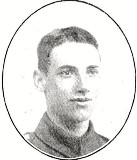
Joseph Martin, Private, 16769, Royal Welsh Fusiliers. Joseph was born in Breage, Cornwall in 1892, the son of Samuel and Mary Martin. By 1911 the family was living at Bryncoedifor, Dolgellau, and Samuel had become Headmaster of Dolgellau Council School. Joseph worked on a local farm prior to the war. He enlisted at Wrexham into the 13th Battalion, Royal Welsh Fusiliers in September 1914. The battalion was raised at Rhyl on 3 September 1914 by the Denbigh & Flint TF Associations and transferred to the Welsh National Executive Committee on 10 October and moved to Llandudno the following month, joining 128 Brigade, 43rd (Welsh) Division. On 28 April 1915 the formation became renumbered as 113 Brigade, 38th (Welsh) Division, and moved to Winchester in August for final training. From 1 December 1915 the Division began embarking for France, and moved to the Nursery Sector near Fleurbaix for trench initiation alongside the Guards Division. The Division then held a sector of the line near Cuinchy before marching south to the Somme sector in June 1916 to take part in the assault on Mametz Wood. The first attack on the wood was launched on a two-battalion front on 7 July, but failed, and the Divisional Commander, Sir Ivor Philipps, was replaced before the Division attacked again on a two Brigade front on 10 July 1916. After two days of severe fighting, the wood was cleared up to its northern boundary, and the battered Division was relieved, moving to Hébuterne before taking over the Canal Bank Sector at Boesinghe, north of Ypres. On 2 September 1916 the 13th RWF moved into the new line for its first tour in the trenches at the Canal Bank. Over the coming weeks the men of the Division worked hard, improving the trenches while guarding the front, and carried out a number of trench raids. On 29 October 1916 the 13th RWF was back in the front line again, and on their flank the 16th RWF carried out another trench raid. In retaliation, the Germans bombarded the front line with Trench mortar rounds, and Joseph was killed in the barrage. He was 24-years-old when he was killed that day, and is buried in Essex Farm Cemetery, Ypres, Belgium.
Robert Henry Mills, Major, Royal Welsh Fusiliers. Robert was the son of Richard and Jane Mills of Maldwyn House, Dolgellau. Robert had enlisted into the 9th Battalion, Imperial Yeomanry on 15 February 1901 and had served in South Africa during the Boer War, and continued to serve with the local 7th RWF Territorials upon his return. He married Margaret Gwynne Williams in 1909 and the couple lived at Brynbela, Dolgellau, where Robert worked in the family Grocery business. Following the outbreak of war, he gained a commission into the 14th Battalion, Royal Welsh Fusiliers on 25 November 1914, joining the battalion at Llandudno, where it was attached to 128 Brigade, 43rd (Welsh) Division. The battalion trained in North Wales before moving to Winchester in the summer of 1915, where the formation became renumbered 113 Brigade, 38th (Welsh) Division. The Division moved to France on 2 December 1915 and moved to the Nursery Sector near Fleurbaix for trench initiation alongside the Guards Division. The Division then held a sector of the line near Cuinchy before marching south to the Somme sector in June 1916 to take part in the assault on Mametz Wood. By now Robert had been promoted to Major, and was second-in-command of the battalion. The first attack on the wood was launched on a two-battalion front on 7 July, but failed, and the Divisional Commander, Sir Ivor Philipps, was replaced before the Division attacked again on a two Brigade front on 10 July 1916. Robert was killed in the wood on 10 July 1916. The 35-year-old is buried in Dantzig Alley British Cemetery, Mametz, France.
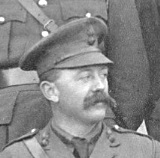
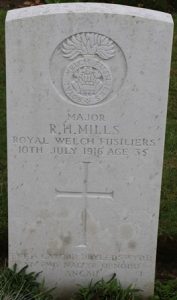
Evan Morgan, Private, 291462, Royal Welsh Fusiliers. Evan was the son of Cadwaladr and Margaret Morgan, of 3, Lichfield Terrace, Abergwynolwyn. He worked as a Quarryman prior to enlisting at Dolgellau into the 7th Battalion, Royal Welsh Fusiliers on 14 December 1915 and was placed on the Army Reserve. Evan was mobilised on 9 February 1916 and after completing his training embarked for Egypt on 10 June 1916. Evan was then posted to the 8th Battalion, Royal Welsh Fusiliers, which had just left Egypt for service in Mesopotamia, and was attached to 40 Brigade, 13th (Western) Division. The Division came under orders of the Tigris Corps, and then took part in the attempts to relieve the besieged garrison at Kut. However, after these efforts failed and Kut fell, the British force in the theatre was built up and reorganised and the Division took part in the lengthy campaign to drive the Turks out of Mesopotamia, in terrible conditions. Turkey signed an Armistice on 31 October 1918, and less than two weeks later Germany surrendered. Evan suffered two bouts of fever before being sent home for demobilisation, and was on his way back through France when he fell ill, and was hospitalised at the 2nd General Hospital at Le Havre. He died of pneumonia there on 13 March 1919, aged 28. Evan was buried in Ste. Marie Cemetery, Le Havre, France.
Francis Vaughan Morris, Private, 30193, Northumberland Fusiliers. Francis was the son of Francis and Catherine Morris, of Park Row, Dolgellau. He married Eleanor Roberts whilst working in Liverpool in 1907, and the couple moved to 13, Bromsgrove Street, Grange, Cardiff by 1911, where Francis worked as a Bootmaker. He had moved the family to Bradford prior to the war, and enlisted there into the Northumberland Fusiliers. After completing his training, Francis was posted to the 8th Battalion, Northumberland Fusiliers, which was in France attached to 34 Brigade, 11th (Northern) Division. Francis probably joined the battalion on the Somme, following its move from Egypt. The Division took part in the Battle of Flers-Courcelette during the Somme Offensive, and spent the winter on the Ancre. In June 1917 the Division took part in the Battle of Messines, and then fought at the Battle of Langemarck during the Third Battle of Ypres. At the end of September, the Division took part in the Battle of the Polygon Wood, then fought at the Battle of Broodeseinde and the Battle of Poelcapelle. The Division didn’t see any more major fighting for some months after the Passchendaele Offensive had been closed down, until taking part in the great offensive from 21 August 1918, fighting during the Second Battle of Arras. The 11th Division advanced from the direction of Arras towards the Hindenburg Line over the coming weeks, taking part in the Battle of Drocourt-Queant, then moved on, fighting at the Battle of the Canal du Nord, then at the Battle of Cambrai at the beginning of October. Francis had been wounded during the heavy fighting for Cambrai, and was evacuated to Hospital at Étaples, where he died of his wounds on 9 October 1918, aged 33. He is buried in Étaples Military Cemetery, France.
James Meredith Morris, Private, 291272, Royal Welsh Fusiliers. James was the son of Meredith Mathew Morris and Anne Morris, of Tudno Villa, Dolgellau. He worked as a Butcher prior to the war. James enlisted at Tywyn into the 7th Battalion, Royal Welsh Fusiliers on 23 November 1915, and was posted to the 3/7th RWF at Park Hall Camp, Oswestry for training. On 26 June 1916 James embarked at Devonport for Egypt, joining the 1/7th Battalion, Royal Welsh Fusiliers, which was attached to 158 Brigade, 53rd (Welsh) Division. The Division had been evacuated from Gallipoli in December 1915, moving to Egypt to join the EEF, and helped guard the Suez Canal before taking part in operations to drive the Turks out of the Sinai. The EEF then turned its attention onto driving the Turks out of Palestine, and on 26 March 1917 launched its first offensive against the coastal city of Gaza, which guarded the road to Jerusalem. Initial gains during the day were lost when the assaulting divisions lost touch with each other and communication broke down when a thick fog cloaked the battlefield. James was among a large number of men killed during the days fighting. The 21-year-old is buried in Gaza War Cemetery, Palestine.
Griffith Christmas Owen, Second Lieutenant, South Wales Borderers. Griffith was born on 25 December 1886, the son of Hugh and Ellen Owen, of Bryngwenallt, Dolgellau. He worked as an Ironmongers Assistant at Oswestry prior to the war. Griffith enlisted into the army and was posted to the 64th Training Reserve Battalion at Kinmel Park. He was commissioned as Second Lieutenant into the South Wales Borderers on 1 March 1917 and was posted to France in June 1917, joining the 11th Battalion, South Wales Borderers at Proven on 25 June. The Battalion was out of the line, and on 28 June moved to Westerehem, to carry out training in readiness for the forthcoming offensive at Ypres. The 11th SWB was attached to 115 Brigade, 38th (Welsh) Division, which was holding the Canal Bank sector at Boesinghe, and the objective for the Division in the forthcoming attack was Pilckem Ridge. By 19 July the 11th SWB was back at Proven and had began its move back towards the battle area. During the afternoon of 29 July, the battalion was addressed by Brigadier General Gwynne Thomas, DSO, who wished the men success in the forthcoming offensive and by 21.30 on 30 July the battalion began moving into position on the Canal Bank, together with the other attacking battalions of the Division. The Divisions assault on the Pilckem Ridge was launched at 3.50 on 31 July 1917 and the attacking troops fought their way over the muddy battlefield, clearing concrete pill-boxes as they advanced towards their objective of the Steenbeek. Griffith was killed in action during the terrible fighting that day. The 30-year-old was originally buried on the battlefield, north of Stray Farm, but in April 1928 his grave was discovered, and he was identified by his uniform and personal effects, before being re-buried in Sanctuary Wood Cemetery, Ypres.
Harry Owen, Private, 241432, Royal Welsh Fusiliers. Harry was born in Nant Gwynant, near Beddgelert, in 1893, the son of Griffith and Anne Owen. Prior to the war the family had moved to Frongaled, Dolgellau. Harry lived at St. Asaph prior to the war and enlisted at Rhyl into the 5th Battalion, Royal Welsh Fusiliers. He was posted to the reserve battalion at Bedford, and in July 1916 embarked for Egypt, joining the 1/5th Battalion, Royal Welsh Fusiliers, which was attached to 158 Brigade, 53rd (Welsh) Division. The Division had been evacuated from Gallipoli in December 1915, moving to Egypt to join the EEF, and helped guard the Suez Canal before taking part in operations to drive the Turks out of the Sinai. The EEF then turned its attention onto driving the Turks out of Palestine, and on 26 March 1917 launched its first offensive against the coastal city of Gaza, which guarded the road to Jerusalem. Initial gains during the day were lost when the assaulting divisions lost touch with each other and communication broke down when a thick fog cloaked the battlefield. Harry was killed in action during the desperate fighting that day. The 23-year-old is buried in Gaza War Cemetery, Palestine.
Herbert Ernest Malcolm Owen, Second Lieutenant, Royal Flying Corps. Herbert, known as Malcolm, was born at Llanfairfechan on 27 October 1898, the son of Reverend Edwin James Owen and Jessie Beatrice Owen (nee Paterson). By 1901 the family was living at Coed, Brithdir, where Reverend Owen had taken over the position of Rector at St. Mark’s Church. Malcolm was educated at Ruthin Grammar School, where he excelled as a sportsman. Herbert enlisted into the Royal Flying Corps on 10 March 1917 and was posted to Reading, gaining a commission as Second Lieutenant on 30 May 1917. He was then posted to the Flying School at Hendon, to train as a pilot. Malcolm was awarded his Aviator’s Certificate on 16 June 1917, after learning to fly a Caudron biplane at the Ruffy-Bauman School. He was then posted to 60 Training Squadron, RFC. On 18 July 1917 Malcolm was flying an Avro 504, Serial A5930, from Scampton. He had just taken off, but the aircraft stalled and crashed to the ground, bursting into flames. Malcolm was knocked unconscious in the crash, thus unable to free himself from the wreckage, and despite attempts from some men to free him, he was burnt to death. The remains of the 18-year-old were conveyed home for burial in St. Mark’s Churchyard, Brithdir.

Hugh Richard Owen, Sergeant, 28704, Royal Field Artillery. Hugh was born in Dolgellau in 1896, the son of Hugh and Elizabeth Owen. By 1911 the family was residing at 39, Royal Cottage, Mardy, where Hugh and his father worked as Colliers. Hugh enlisted at Mardy into the Royal Field Artillery soon after the outbreak of war, and was posted to C Battery, 75th Brigade, Royal Field Artillery, which was attached to the 16t (Irish) Division. Hugh embarked with the Battery for France on 2 September 1915, and the entire 16th Division concentrated in the Bethune area. The Division saw its first major action during the Somme Offensive, at the Battle of Guillemont, and also fought at the Battle of Ginchy. By May 1917 the Division had moved to positions south of Ypres, taking part in the Battle of Messines, before moving north, and taking part in the Battle of Langemarck. The 16th Division was then transferred south to the Cambrai Sector in order to take part in a diversionary assault, to divert German attention away from the forthcoming Battle of Cambrai. The Division moved to the Croisilles area opposite the German held Tunnel Trench, near Bullecourt, and on 20 November began launching its offensive, capturing the trench and dugouts. Hugh was killed in action when his battery was supporting further fighting here on 30 November 1917. The 21-year-old has no known grave and is commemorated on the Cambrai Memorial, Louverval, France.
John Aneurin Owen, Private, 54612, Machine Gun Corps. John was the son of Owen Edward Owen and Jane Owen, of Tycerrig, Llanfachreth. He enlisted at Holywell into the Royal Welsh Fusiliers, and after completing his training was posted to France, joining the 47th Battalion, Machine Gun Corps. The battalion was attached to the 47th Division, and was formed in February 1918, whilst the Division was in the St. Quentin area. The Division faced the German Spring Offensive here on 21 March, and took part in an epic rear-guard action during the coming days. The fighting calmed down in this area over the coming months, after the Germans switched their attentions elsewhere. John was wounded whilst the Division was still in the area, and died of his wounds on 1 August 1918, aged 22. He is buried in Warloy-Baillon Communal Cemetery Extension, France.
John Herbert Owen, Private, G/13357, Royal West Kent Regiment. John was the son of William and Esther Owen of 16, Talarran Terrace, Dolgellau. He worked as an engineer prior to enlisting at Newtown into the 7th Battalion, Royal Welsh Fusiliers on 1 December 1914. He was posted to the 2/7th Battalion at Northampton, but his disciplinary record was poor, and he was then transferred to the 47th Provisional Battalion in Mundesley, Norfolk on 19 June 1915. John was discharged from the battalion under the Military Service Act on 12 April 1916 and enlisted at Norwich the following day into the Royal West Kent Regiment and was drafted to France on 2 July 1916, joining the 7th Battalion, Royal West Kent Regiment, which was on the Somme attached to 55 Brigade, 18th (Eastern) Division. John saw his first action when the 18th Division took part in the Battle of Bazentin, where the Division captured Trônes Wood, and then took part in the Battle of Delville Wood. In October the Division took part in the Battle of the Ancre Heights, capturing Schwaben Redoubt, and helped capture Regina Trench. The Division then fought at the Battle of the Ancre, and during the subsequent Operations on the Ancre, before spending the winter on the Somme. In March 1917 the Division followed the German Retreat to the Hindenburg Line. John was wounded during the advance and on 25 March 1917 he returned to England for further hospital treatment. Upon his recovery he returned to France on 25 October 1917, re-joining the 6th Battalion, Royal West Kent Regiment, which was attached to 37 Brigade, 12th (Eastern) Division. The Division took part in the Battle of Cambrai in November 1917, before being relieved at the beginning of December, and moved to positions near Albert to rest. The Division relieved the 38th (Welsh) Division in the Fleurbaix front line in February 1918, and on 24 March was moved back south to the Somme sector, following the German offensive which had been launched on 21 March. John was wounded in the head during fighting around Bapaume on 28 March, and was evacuated to the 11th Stationary Hospital at Rouen, where he died of his wounds on 1 April 1918, aged 24. He is buried in St. Sever Cemetery Extension, Rouen, France.
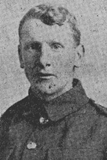
Owen Owen, Private, 10004, South Wales Borderers. Owen was the son of Edward and Elizabeth Owen of Bontyrarran, Dolgellau. He worked as a Labourer prior to enlisting into the Royal Welsh Fusiliers on 9 October 1895, and over the coming years served overseas, at Malta, Crete, Egypt and in China, taking part in the Relief of Peking, during the Boxer Rebellion. He had a long list of defaults in his name, for mostly minor offences, during his time overseas, and in 1904 deserted. Owen was then placed on the Army Reserve in December 1902 and left the army; his conduct being marked as ‘indifferent’ in his papers. He then moved to South Wales to work as a Collier. Owen re-joined the Colours at Abergavenny at the outbreak of war, and was posted to the 1st Battalion, South Wales Borderers, which was attached to 3 Brigade, 1st Division. The Division had been one of the first to arrive in France, fighting at the Battle of Mons, and taking part in the retreat to the Marne, where the Germans were stopped. They then fought at the Aisne, and at Chivy, before being moved north to Ypres. Here they fought at the First Battle of Ypres, where the Division took up positions around Gheluvelt, on the Menin Road, in an attempt to stop the German drive towards the Channel ports. Owen survived the horrific Battle of Gheluvelt on 31 October, when the Germans were stopped, following a suicidal defence by the 2nd Welsh and 1st SWB, followed by a gallant counter-attack by the 2nd Worcester’s. The Germans then launched a last-ditch offensive on 11 November, which was held off by the British, and the First Battle of Ypres drew to a close. Owen was killed at Ypres soon afterwards, on 18 November 1914, aged 38. He has no known grave, and is commemorated on the Menin Gate Memorial, Ypres, Belgium.
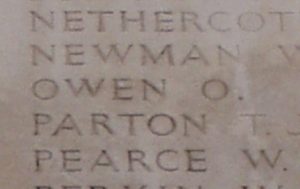
Owen Owen, MM, Sergeant, 23309, Royal Garrison Artillery. Owen was born at Dolgwartheg, Dolgellau, the son of Richard and Margaret Owen. By 1911 his father was dead, and his mother lived at 56, Commercial Street, Bargoed, with Owen’s brother Richard. Owen had enlisted into the Royal Monmouthshire Royal Engineers (RMRE) at Tredegar on 17 May 1905. The unit was a Militia unit which ran in the same way as the Territorial units, running Summer Camps and mobilising, when needed, for war. Following the outbreak of the Great War, Owen did not remain with the RMRE, but instead enlisted into the Royal Garrison Artillery, and was posted to the 14th Siege Battery, RGA. The battery was attached to the 29th Division, and embarked for Egypt in April 1915. The Division then moved to Gallipoli from Egypt, landing on 25 April 1915, and fought throughout the entire Gallipoli campaign. The Division was evacuated to Egypt on 11 January 1916, and then moved to the Western Front on 15 March 1916, taking up positions facing Beaumont Hamel, on the Somme. The Division took part in its first major action in France during the 1916 Somme Offensive, launching a suicidal assault against Y-Ravine at dawn on 1 July 1916, where it suffered terrible casualties. Owen was killed in action by counter-battery fire three days later, on 4 July 1916, aged 32. He is buried in Couin British Cemetery, France. He had been awarded the Military Medal, for Bravery in the Field, not long prior to his death.
William Robert Owen, Private, 291073, Royal Welsh Fusiliers. William was the illegitimate son of Elizabeth Owen, of Dyffryn, Barmouth. He was raised by his Aunt, Mrs Susannah Jones, at Trawsfynydd, before re-joining his mother at some time prior to 1911, as they were living as tenants at Caemawr, Ganllwyd. He enlisted at Dolgellau on 23 April 1915 into the 2/7th Battalion, Royal Welsh Fusiliers and was posted to Northampton with the battalion. On 26 June 1915 William was transferred to the 1/7th Battalion, Royal Welsh Fusiliers. The battalion was a Territorial unit, which mobilised for war at Newtown in August 1914, as part of North Wales Brigade, Welsh Division and moved to Conway until the end of the month, before moving to Northampton. In December the Division moved to Cambridge and then in May 1915 to Bedford, where the Division was numbered and the formation became 158 Brigade, 53rd (Welsh) Division. On 19 July 1915 the entire Division sailed from Devonport for Imbros and on 9 August 1915 landed at Suvla Bay. The Division was eventually evacuated from Gallipoli in December 1915, moving to Egypt to join the EEF, and helped guard the Suez Canal before taking part in operations to drive the Turks out of the Sinai. The EEF then turned its attention onto driving the Turks out of Palestine, and on 26 March 1917 launched its first offensive against the coastal city of Gaza, which guarded the road to Jerusalem. The battle was a failure for the EEF, and a second assault on Gaza was launched on 17 April which also failed, resulting into the Commander of the EEF being replaced by Sir Edmund Allenby. He reorganised the EEF before launching a third offensive on a wider front, from Beersheba to Gaza, on 6 November 1917, which broke the Turkish lines. William was killed in action that day, during the Third Battle of Gaza. The 22-year-old is buried in Beersheba War Cemetery, Israel.
Peter Price, Private, 39140, South Wales Borderers. Peter was the son of John and Anne Price of Fronoleu, Dolgellau. He originally enlisted at Newport, Mon into the Welsh Horse Yeomanry, but did not embark for Gallipoli with the Welsh Horse in 1915, and instead transferred to the South Wales Borderers. Peter was posted to France in the Summer of 1916, joining ‘D’ Company, 1st Battalion, South Wales Borderers, which was attached to 3 Brigade, 1st Division. Peter would have seen his first action during the Somme offensive that Summer, probably during the Battles of Flers-Courcelette and Morval. The Division followed the German retreat to the Hindenburg Line in early 1917, and was then briefed for an operation on the Flanders Coast, moving there during the summer of 1917. Whilst preparing for a possible offensive along the coast, the Third Battle of Ypres had stalled in the mud, and the Division was sent to Ypres, taking part in the Second Battle of Passchendaele. After spending another Winter in Flanders, the Division was near Éstaires when the second phase of the German Spring Offensive hit the Lys Valley, and the 1st Division took part in desperate fighting over the coming days. The Division remained in the Loos sector after the fighting had died down, and enjoyed a relatively peaceful few months in the line. The 1st SWB relieved the 2nd Welsh in the line in the Cambrin North Sub-Sector on 19 July, to begin another routine tour in the trenches. At 03.00 on the morning of 22 July 1918, Second Lieutenant J. H. Hall took out one Platoon of D Company on a trench raid, to gather intelligence. Peter was killed in action during the raid that morning. The 24-year-old is buried in Cambrin Military Cemetery, France.
Arthur Pugh, Private, 2528, Welsh Guards. Arthur was the son of Hugh and Ellen Pugh, of Tynymynydd Cottage, Brithdir, Dolgellau. He served as a Policeman in Mountain Ash prior to the war, and enlisted at Mountain Ash into the newly formed 1st Battalion, Welsh Guards in February 1915. The Regiment was raised by Royal Warrant of 26 February 1915, at White City, before landing at Le Havre on 18 August 1915, becoming attached to 3rd Guards Brigade, Guards Division. The Division saw its first major action during the Battle of Loos, which began on 25 September 1915, and suffered severe casualties at Hill 70. The Guards remained in the area during the coming months, where the Division also fought in the subsequent Action of Hohenzollern Redoubt. In July 1916 the Division moved to the Somme, where it took part in the Battle of Flers-Courcelette from 15 to 22 September, the first time that tanks were used in action. Arthur was badly wounded during the battle, and was evacuated to No 3 Stationary Hospital at Rouen, where he died of his wounds on 22 September 1916, aged 22. He is buried in St. Sever Cemetery Extension, Rouen, France. His brother, Richard, died in France in 1918.
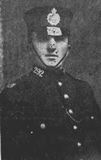
Howell Pugh, Sapper, 79934, Royal Engineers. Howell was the son of Hugh and Mary Pugh, of Hendregefeilliaid, Dolgellau. He worked as a Labourer prior to enlisting at Dolgellau into the 4th Battalion, Royal Welsh Fusiliers on 15 March 1903, and served for five years before being discharged and joining the Army Reserve. Howell married Hannah Rowlands in 1908, after his discharge, and the couple lived at 1, South Street, Dolgellau. Following the outbreak of war, Howell-re-enlisted into the Royal Welsh Fusiliers and embarked for France on 19 May 1915, initially destined for the 1st RWF. He was then transferred to the 176th Tunnelling Company, Royal Engineers, which had formed in April 1915, and was at Givenchy, carrying out work on underground mines and deep dugouts. Howell took ill in the Autumn of 1915, and died in hospital at St. Venant on 25 October 1915, aged 25. He is buried in St. Venant Communal Cemetery, France. His brother, Hugh, was killed in 1917.
Hugh Pugh, Private, 291412, Royal Welsh Fusiliers. Hugh was the son of Hugh and Mary Pugh, of Hendregefeilliaid, Dolgellau. He worked as a Railway Porter at Corwen prior to becoming a Ministerial Student. Hugh enlisted at Dolgellau into the 7th Battalion, Royal Welsh Fusiliers on 11 December 1915 and was posted to Park Hall, Oswestry. On 6 September 1916 Hugh embarked at Devonport for Egypt, joining the 1/7th Battalion, Royal Welsh Fusiliers, which was attached to 158 Brigade, 53rd (Welsh) Division. The Division had been evacuated from Gallipoli in December 1915, moving to Egypt to join the EEF, and helped guard the Suez Canal before taking part in operations to drive the Turks out of the Sinai. The EEF then turned its attention onto driving the Turks out of Palestine, and on 26 March 1917 launched its first offensive against the coastal city of Gaza, which guarded the road to Jerusalem. Initial gains during the day were lost when the assaulting divisions lost touch with each other and communication broke down when a thick fog cloaked the battlefield. Hugh was killed in action during the desperate fighting that day. The 22-year-old has no known grave and is commemorated on the Jerusalem Memorial, Israel.
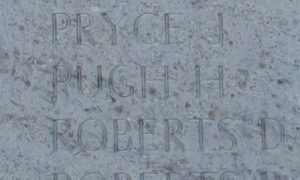
Joshua Henry Pugh, Gunner, W/2814, Royal Field Artillery. Joshua was the son of Griffith and Jane Pugh of 2, Fronallt Terrace, Dolgellau. He married Elizabeth Ann Davies at Merthyr in 1907, and the couple set up home at 10, Victoria Street, Merthyr Vale, where Joshua had found work as a coalminer. He enlisted at Treharris into the Welsh Division, Royal Field Artillery soon after the outbreak of war. The Divisional Artillery trained in North Wales, originally without guns, by using mock ups made with telegraph poles, before the entire 38th (Welsh) Division moved to Morn Hill Camp, Winchester for final training in the Summer of 1915, and Joshua joined the 38th Trench Mortar Battery. During December 1915 the entire Division embarked for France, and assembled in the Nursery Sector, near Fleurbaix, for trench initiation alongside the Guards Division. The Division then held a sector of the line near Cuinchy before marching south to the Somme sector in June 1916 to take part in the assault on Mametz Wood. The first attack on the wood was launched on a two-battalion front on 7 July, but failed, and the Divisional Commander, Sir Ivor Philipps, was replaced before the Division attacked again on a two Brigade front on 10 July 1916. After two days of ferocious fighting, the wood was cleared up to the northern edge, and the battered Division was moved to the line at Hébuterne, before taking over a new section of front along the Canal Bank sector, at Boesinghe, north of Ypres. Joshua was badly wounded by counter battery fire on 30 June 1917, and died that same day at the Casualty Clearing Station at Proven. The 36-year-old is buried in Mendinghem Military Cemetery, Poperinghe, Belgium. He is also commemorated on the Aberfan memorial.
Richard Llewellyn Pugh, Sapper, 2008296, Canadian Engineers. Richard was born on 4 June 1891, the son of Hugh and Ellen Pugh, of Tynymynydd Cottage, Brithdir, Dolgellau. He had emigrated to the United States in 1908 and settled at 27, East Hillside Avenue, Plymouth, Pennsylvania, where he worked as a coalminer, and married Marion Hartman there in 1916. Richard travelled to Toronto, Canada to enlist in the Canadian Engineers on 9 April 1918, possibly after having been rejected by the US Army. On 15 May 1918 Richard embarked in Canada aboard the SS City of Marseilles, and disembarked in England on 5 June, joining the Reinforcement Pool, Canadian Engineers at Seaford. On 17 October Richard joined the 3rd Tunnelling Company, Canadian Engineers in France. Unfortunately, he became ill towards the end of the war and was brought to the 7th Canadian General Hospital, at Le Treport, where he died of broncho-pneumonia on 16 November 1918, aged 27. He is buried in Étaples Military Cemetery, France. His brother, Arthur, died of wounds in France in 1916.
Robert Pughe, Flying Officer, Royal Air Force. Robert was the son of Robert and Jane Mary Pughe, of Helygog, Dolgellau. He enlisted into the Royal Welsh Fusiliers in 1918, and served in France towards the end of the war with the 17th Battalion, Royal Welsh Fusiliers. After the Armistice, he volunteered to serve in the Royal Air Force and trained as a pilot, before being posted out to Quetta, India with 5 Squadron, RAF. On 16 April 1920, Robert was flying a Bristol Fighter, Serial F4627, of 5 Squadron, on a routine mail flight, when he crashed whilst turning over Loralai. The 21-year-old was buried in Loralai Cemetery, India. Due to accessibility issues, the CWGC commemorate him on the Delhi Memorial (India Gate), India.
William Rees, Private, 21885, East Surrey Regiment. William was the son of Robert and Mary Rees, of Ochryfoel Isaf, Dolgellau. He worked in Croydon as a Milkman prior to the war, and in 1909 married Agnes Ellen Samson. William enlisted in Kingston on Thames into the East Surrey Regiment, and was posted to the 9th Battalion, East Surrey Regiment, which was attached to 72 Brigade, 24th Division. The Division had moved to France during August 1915 and marched to positions near Loos, where it took up reserve positions. Despite its inexperience, it was sent into action at Loos on 26 September 1915, and suffered terrible casualties. It was then withdrawn from the line, and didn’t see action until the summer of 1916 when it was moved to the Somme. William would have joined the battalion early in 1916, as it was rebuilding. The Division then fought at Delville Wood and Guillemont, suffering terrible casualties, before moving north of Arras, to Zoave Valley then Hulluch, at the end of September. At the end of March 1917, the 9th East Surreys took up positions at Calonne, and began the normal routine of trench rotation. The battalion was holding the line at Calonne on 9 April 1917, watching overhead as the British artillery continually shelled the German rear positions, as part of the softening up process leading up to the forthcoming Battle of Arras. On the following morning the Germans fired four Minenwerfer shells into the line, killing William. The 29-year-old is buried in Bully-Grenay Communal Cemetery, British Extension, France.
Arthur Randell Roberts, Private, T/241375, The Queen’s (Royal West Surrey Regiment). Arthur was the son of John Isaac Roberts and Elizabeth Roberts, of Sarn Road, Dolgellau. He worked as a Grocer in Wimbledon prior to the war. Arthur married Florence Beard on 11 October 1911, and the couple set up home at 15, Balfour Road, Wimbledon. Arthur enlisted at Wimbledon into the Queen’s (Royal West Surrey Regiment), and was posted to India, joining the 1/5th Battalion, The Queen’s (Royal West Surrey Regiment), which was attached to the 12th Indian Brigade, 15th Indian Division. Arthur served in India for over a year, before he took ill and died of malaria at Bolarum on 21 November 1917, aged 28. He is buried in Bolarum Cavalry Barracks Cemetery, but as the cemetery is inaccessible, the CWGC commemorate him on the Madras 1914-1918 War Memorial, Chennai, India.
Evan Roberts, Corporal, 15100, Royal Welsh Fusiliers. Evan was the son of Evan and Margaret Roberts, of 4, Talyrafon Buildings, Dolgellau. He had enlisted into the 4th Battalion, Royal Welsh Fusiliers at Dolgellau on 12 September 1906, and served with the battalion until 1913, attending every annual summer TA camp up until then. He then left Dolgellau after finding work in Corfe Castle Dorset, and left the Territorials, becoming an Army Reservist. Evan married Frances Lily Gray, of Bushey Dairy, Corfe Castle, in 1915 whilst on leave, after having been called up from the Reserve. He was posted to France soon afterwards, joining the 2nd Battalion, Royal Welsh Fusiliers, which was attached to 19 Brigade. On 25 November 1915, 19 Brigade transferred to the 33rd Division, which had just arrived in France. The Division initially took over a section of the line near Givenchy, then took over the Cambrin sector. The infantry battalions then began the normal routine of rotation, spending, usually, four days in the line, four in reserve, then rest, over the coming months. The 2nd RWF suffered a number of disastrous days in this sector during this time. The most notorious occurred on 22 June 1916, when the Germans blew a massive underground mine beneath the battalions’ positions at The Duck’s Bill, and the battalion lost 54 men in B Company alone, before capturing the massive crater caused by the explosion. The battalion was in the line again on 6 July 1916 when Evan was killed, whilst attached to the Trench Mortar Battery. The 28-year-old has no known grave and is commemorated on the Loos Memorial, France.
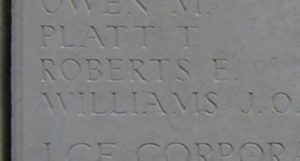
Hugh William Roberts, Private, 9520, Welsh Regiment. Hugh was the son of David and Mary Ann Roberts, of Cader Road, Dolgellau. He had moved to Mountain Ash some years prior to the war and had enlisted there into the Royal Monmouthshire Royal Engineers on 13 May 1907. He later joined the regular army, enlisting into the 2nd Battalion, Welsh Regiment. At the outbreak of war, the battalion moved to France, attached to 3 Brigade, 1st Division. The Division had been one of the first to arrive in France, fighting at the Battle of Mons, and taking part in the retreat to the Marne, where the Germans were stopped. The Division then fought at the Aisne, and at Chivy Ridge, where William Fuller of the 2nd Welsh, became the first Welshman to win the Victoria Cross during the war. The BEF then moved north to Ypres, taking over the defences of the City from the French, and took part in the First Battle of Ypres, where the BEF stopped the German advance on the Channel ports. The 2nd Welsh then moved to Outtersteene to refit and rest before taking over positions East of Festubert before Christmas, 1914. On 27 December the 2nd Welsh supported an attack by the 1st SWB against the Germans opposite, attacking towards Givenchy. Hugh was wounded during the days fighting, and was evacuated to the 4th Clearing Hospital at Lillers, where he died of his wounds on 2 January 1915, aged 29. He is buried in Lillers Communal Cemetery, France. (The CWGC show his date of death as 5 January, but every other existing record shows 2 January).
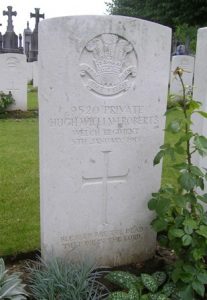
Richard Bowen Roberts, Lieutenant, Westmorland and Cumberland Yeomanry. Richard was born on 1 August 1880, the son of Owen David Roberts and Eliza Jane Roberts (nee Williams), of Dolgellau. He was educated at Dolgellau County School, then at Bradford Grammar School before entering Clare College, Cambridge, graduating BA in 1904. On 26 April 1906 he married Jane Gertrude Thomas, of Amlwch, and the couple had two sons. Following the outbreak of war Richard enlisted into the Denbighshire Hussars on 5 August 1914 and was commissioned into the Westmorland and Cumberland Yeomanry in May 1915. Richard embarked for France in July 1915, and after two years overseas, returned home in December 1917 when his health had begun to suffer. He died of heart failure at his home at Plas Penrhyn, Dwyran, Anglesey on 13 January 1918, aged 37. Richard was buried with full military honours in St. Edwen’s Churchyard, Llanedwen, Anglesey.
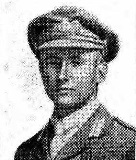
Richard Henry Roberts, Private, 78530, Tank Corps. Richard, known as Harry, was born in Chester on 30 May 1887, the son of Richard Roberts and Sarah Roberts (nee Mills). Following the death of his father in 1898, his mother moved the family back to her native Dolgellau, and they lived at Cambrian House, Dolgellau. Henry was educated at Chester College and at Dolgellau County School, before working as a Grocer for his Uncle, Henry Miles. Henry enlisted into the Royal Army Ordnance Corps on 14 November 1915, but following the formation of the Tank Corps, volunteered to serve with the new regiment in 1917 and was posted to the 9th Battalion, Tank Corps. As the final year of the war dawned, Harry was with his battalion at Bray, on the Somme, where the battalion was in GHQ Reserve. At dawn on 21 March 1918, the Germans launched a massive offensive along the stretch of the line running from the Flesquières Salient down to La Fère, and the British front line was overwhelmed. Although some tanks were in action on that first morning, several other battalions of the Tank Corps were rushed forward to attempt to stem the attack. The 9th Battalion handed its tanks over to the 3rd Battalion, and moved forward from Bray on 24 March as a Lewis-Gun Battalion to assist the 35th Division in the defence of Montauban and Maricourt. Harry was posted as missing in action during heavy fighting near Maricourt on 25 March 1918. There were various reports that he had escaped from his tank but was then killed, and also reports that he had been taken prisoner, but he was later officially confirmed as having been killed in action on that date. The 30-year-old has no known grave and is commemorated on the Pozieres Memorial, France.

Thomas Roberts, Private, 2850, Royal Welsh Fusiliers. Thomas was the son of Thomas and Emily Roberts, of Tyn Llidiart, Arthog. He enlisted at Dolgellau into the 1/7th Battalion, Royal Welsh Fusiliers. The battalion was a Territorial unit, and assembled for war at Newtown on 4 August 1914, attached to North Wales Brigade, Welsh Division. The battalion moved with the division to Conway until the end of August then to Northampton and by May 1915 was in Bedford, when the formation became 158 Brigade, 53rd (Welsh) Division. On 19 July 1915 the division sailed from Devonport for Imbros and on 9 August 1915 landed at Suvla Bay, Gallipoli. The infantry advanced from the beaches into the bush, but had limited maps and no knowledge of the terrain, so as a result, the landings soon turned into chaos. Thomas was killed in action on the second day, 10 August 1915, aged 22. He has no known grave and is commemorated on the Helles Memorial, Gallipoli. He is also commemorated on the Arthog War Memorial.
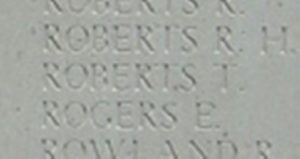
William Roberts, Private, 55315, Royal Welsh Fusiliers. William was the son of Evan and Margaret Roberts, of 4, Talyrafon Buildings, Dolgellau. He worked as a Labourer prior to enlisting at Welshpool into the Royal Welsh Fusiliers. He was stationed for a while at a radio station in Tywyn, but in the Autumn of 1916 embarked for France, before being posted to the 14th Battalion, Royal Welsh Fusiliers. The Battalion was on the Canal Bank at Boesinghe, attached to 113 Brigade, 38th (Welsh) Division, having taken the sector over following the terrible fighting at Mametz Wood in July. The trenches here were in a poor state, and while the infantry battalions of the Division carried out their normal routine of trench rotation over the coming months, the men were kept busy repairing and improving trenches, as well as digging further saps and carrying out patrols in No Man’s Land, as well as trench raids. On 21 February 1917 the 14th RWF relieved the 13th RWF in the front line to begin another tour. The enemy were quiet, so the men carried out work on dugouts and a new Company HQ. During the afternoon of 24 February, the Germans opened up an artillery barrage upon the front line, followed up by a fifty strong raiding party, which entered the battalion’s line and took a man, Sergeant Jones, prisoner. The artillery barrage caused heavy casualties to a party of men of the 19th Welsh working behind the line, and also to the 14th RWF. William was killed in action on the following day, 25 February 1917, just prior to the battalion being relieved. The 33-year-old is buried in Bard Cottage Cemetery, Belgium. His brother, Evan, was killed in France in 1916.
Edward Rowlands, Private, 2186, Welsh Guards. Edward was the son of Thomas and Catherine Rowlands, of Lletty Canol, Brithdir, Dolgellau. He worked on his father’s farm prior to enlisting at Dolgellau into the Welsh Guards. The Regiment was raised by Royal Warrant of 26 February 1915, at White City, before landing at Le Havre on 18 August 1915, becoming attached to 3rd Guards Brigade, Guards Division. The Division saw its first major action during the Battle of Loos, which began on 25 September 1915, suffering heavy casualties at Hill 70, and also saw further fighting at the subsequent Action of Hohenzollern Redoubt. The Guards then wintered in the Ypres Salient, before moving to the Somme at the end of July 1916 and took over positions at Beaumont Hamel for a short while. On 25 August the Guards moved slightly south, to Maricourt, to begin preparations for the forthcoming Battle of Flers-Courcelette, the first time that tanks would be used in action. By now, however, Edward had taken ill and had been evacuated to the 39th Casualty Clearing Station at Allonville, where he died of dysentery on 11 September 1916, aged 23. He is buried in Allonville Communal Cemetery, France.
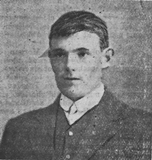
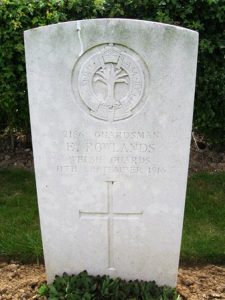
Francis Thomas Ruddle, Rifleman, 2541, The King’s (Liverpool Regiment). Francis was born in Seaforth, Lancashire in 1895, the son of Francis William Ruddle and Mary Ellen Ruddle (nee Roberts). He was baptised at St. Mary’s, Dolgellau on 3 November 1895. He was raised in Seaforth before being educated at his mothers native Dolgellau, then returned to Liverpool after the outbreak of war, enlisting there into 1/6th Battalion, The King’s (Liverpool Regiment) on 21 September 1914. The battalion mobilised for war at Princes Park Barracks, Upper Warwick Street, Liverpool, attached to Liverpool Brigade, West Lancashire Division, and upon landing at Le Havre on 25 February 1915 the battalion joined 15 Brigade, 5th Division at Bailleul. The Division then moved back to Ypres, taking over the Hill 60 sector. Hill 60 was a mound made from spoil excavated during the digging of the Ypres to Comines railway. It afforded an uninterrupted view across to Ypres, so was an important strategic position. The Germans had captured the position from the French during the First Battle of Ypres, so the British were desperate to regain the position, which was frequently mined by both sides, and had become one of the most fought over sections of the front. The 5th Division captured the Hill on 17 February, and on 1 May the Germans launched a gas attack against the troops garrisoning Hill 60, before launching an infantry assault. Desperate fighting during the day saw the Germans beaten off, but on 5 May 1915 the Germans launched another attack, again behind a gas screen. With the defenders smothered in a thick gas cloud, the Germans assaulted and took the hill after a day of desperate fighting. Francis had been among the many men killed in action during the fighting of 5 May 1915. The 19-year-old has no known grave and is commemorated on the Menin Gate Memorial, Ypres. His mother attempted to trace her sons grave over the coming years, but was unsuccessful, as the battlefield was devastated by further fighting throughout the war, and many graves were lost forever. The site of Hill 60 today is considered to be one mass war grave, due to the men lost forever fighting over, and under, it.
Mary Elizabeth Smith, Forewoman, 7820, Queen Mary’s Army Auxiliary Corps. Mary was the daughter of Richard and Susannah Jones, of Park Lane, Dolgellau. She married Isaac Smith, in Liverpool, in 1914. Mary enlisted at Wrexham into Queen Mary’s Army Auxiliary Corps. The corps was formed following a January 1917 War Office recommendation that women should be employed in non-combatant roles in the British Army in France and was divided into four sections including cookery, mechanical and clerical work. Mary contracted tuberculosis during her time in khaki, and died of tuberculosis on 21 August 1918, aged 42. Her remains were brought home for burial in St. Mary’s Churchyard, Dolgellau.
William Charles Stevens, Lance Corporal, 25857, Herefordshire Regiment. William was the son of John and Elizabeth Stevens, of Bethnal Green. He had gone to sea as a young man, but left the service soon afterwards, before coming to west Wales to work as a farm labourer. William had enlisted into the 3rd Battalion, South Wales Borderers before the outbreak of war, and embarked for France with the 1st Battalion, South Wales Borderers on 13 August 1914. The battalion was attached to 3 Brigade, 1st Division, and moved to Mons with the BEF. The Division had been one of the first to arrive in France, fighting at the Battle of Mons, and taking part in the retreat to the Marne, where the Germans were stopped. It then fought at the Aisne, and at Chivy Ridge, before being moved north to Ypres. Here the Division fought at the First Battle of Ypres, helping stop the German drive towards the Channel ports, before being moved to the Festubert and Givenchy area over the winter. The following year saw the Division in action at the Battle of Aubers, before moving South to Loos, taking part in heavy fighting during the Battle of Loos, and the action at the Hohenzollern redoubt. William must have been wounded and returned to Britain for treatment. He married Kate Morris at Liverpool in 1916. Their daughter, Gladys May Stevens, was born at Dolgellau on 18 September 1916. Upon his recovery, William transferred to the Royal Welsh Fusiliers, and was posted out to Egypt, but was then transferred to the 1/1st Battalion, Herefordshire Regiment, which was attached to 158 Brigade, 53rd (Welsh) Division. William probably joined up with the Division in Palestine, following its efforts during the unsuccessful first two Battles of Gaza. A third assault against Gaza was launched on a broad front running from Beersheba to Gaza on the night of 1 November 1917, and this time the line was broken. The 53rd Division then took part in the advance north from Beersheba towards Jerusalem. William was killed in action during the assault by 158 Brigade on Khuweilfeh Hill on 6 November 1917. The 27-year-old is buried in Beersheba War Cemetery, Israel.
Heber Thomas, Second Lieutenant, The Buffs (East Kent Regiment). Heber was born at Ystumtuen on 20 May 1891, the son of Reverend David Thomas, and of Jane Thomas (nee Davies). By 1901 the family were residing at Brynffynon, Dolgellau. Heber worked as a Clerk with the National and Provincial Bank in Mayfair, London prior to the war, and enlisted into the 2/5th Battalion, East Kent Regiment on 8 May 1916. In May 1917 Heber was commissioned, and posted to the 7th Battalion, East Kent Regiment, which was attached to 55 Brigade, 18th (Eastern) Division. The division was at Arras, and moved to Ypres in July, taking part in the Battle of Pilckem, where it helped capture Westhoek. The battalion then moved out of the battle area to train and rest, not returning to the front until reaching St Jan Ter Biezen on 24 September, where a burial service for an officer and 26 men of the battalion took place at Nine Elms Cemetery six days later. On the night of 10 October, the battalion began to move into the front line at Poelcapelle, relieving two battalions of the 11th Division, and by 03.00 on the morning of 11 October the relief was complete. The remainder of the day was quiet, while the battalion prepared to launch an assault on Poelcapelle on the following day. By 04.00 on 12 October 1917 the assaulting Companies were in position, and at 05.25 the men advanced behind a rolling artillery barrage. Unfortunately, the barrage ran too far ahead, and the attacking troops were held up and began to dig in. Over 385 casualties were suffered by the battalion during the failed attack that day. Heber was among ten officers killed or wounded. The 26-year-old has no known grave and is commemorated on the Tyne Cot Memorial, Belgium.
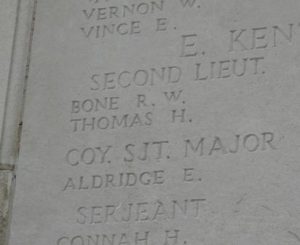
John Walter James Watkins, Private, 64370, Welsh Regiment. John was born at Presteigne, Radnorshire in 1899, the son of John and Ellen Watkins. The family later resided at 16, English Terrace, Dolgellau. John was training to be a clog-maker at Gladestry, Kington when he enlisted at Knighton into the Welsh Regiment on 2 December 1916. He was then too young to serve, so was placed on the Army Reserve, until being mobilised on 17 February 1917, just after turning 18, and was posted to Kinmel Park for training. John embarked for France on 18 January 1918, and was posted to the 9th Battalion, Welsh Regiment, which was holding a sector of the front in the Flesquières Salient, facing the Hindenburg Line. At dawn on 21 March 1918 the Germans launched an intensive artillery bombardment, followed by a gas attack, along the stretch of the Western Front running from Croisilles to La Fere, and followed the gas attack up with a massed infantry assault. The 19th Division was in reserve in the Flesquières Salient when the Germans attacked, and received orders to Stand-To. At just after mid-day the Division had moved into position, the 9th Welsh holding a section of line along the Hermies to Beaumetz Ridge, but then received orders to move to the ridge west of Hermies. As night fell the Division had not been in contact with the enemy. The 9th Welsh withdraw to hold a defensive line east of the village of Beugny on the following morning, and that afternoon came into contact with large numbers of Germans. Heavy fighting then raged on the following day, 23 March, when the Germans hit the 19th Division, but the 9th Welsh doggedly held on while the rest of the Division withdrew. John was killed in action as the heavy fighting continued on the following day, 24 March 1918. The 19-year-old is buried in Bancourt British Cemetery, France.
Frank Ivor Wheeler, Private, 290773, Royal Welsh Fusiliers. Frank was born in 1893, the son of Frank Wheeler and Mary Wheeler (nee Hughes). His father died soon after he was born, so Frank was raised by family in Bryngoleu, Dolgellau. His mother married Owen Luke in 1900, and lived at Taihirion, Llanelltyd, Dolgellau. Frank worked as a farm labourer prior to enlisting at Dolgellau into the 7th Battalion, Royal Welsh Fusiliers on 28 October 1914. The battalion was a Territorial unit, which mobilised for war at Newtown in August 1914, as part of North Wales Brigade, Welsh Division and moved to Conway until the end of the month, before moving to Northampton. In December the Division moved to Cambridge and then in May 1915 to Bedford, where the Division was numbered and the formation became 158 Brigade, 53rd (Welsh) Division. On 19 July 1915 the entire Division sailed from Devonport for Imbros and on 9 August 1915 landed at Suvla Bay. The Division saw heavy fighting over the coming days, then endured a terrible winter, with rain and snow causing flooding so bad one day that even the bodies of the dead were washed out of their graves into the trenches. The Division was eventually evacuated from Gallipoli in December 1915, moving to Egypt to join the EEF, and helped guard the Suez Canal before taking part in operations to drive the Turks out of the Sinai. The EEF then turned its attention onto driving the Turks out of Palestine, and on 26 March 1917 launched its first offensive against the coastal city of Gaza, which guarded the road to Jerusalem. The attack failed, and a second attempt was made on 17 April which also failed, so the EEF was re-organised and suffered a change in command, with Sir Edmund Allenby taking over, before launching a third assault on Gaza on the night of 1 November. This time the EEF succeeded and over the coming weeks captured Jerusalem before advancing further north, driving the Turks out of Palestine. Frank survived all of this, but took ill towards the war and was evacuated to the 19th General Hospital, Alexandria, where he died of pneumonia on 16 November 1918, aged 25. He is buried in Alexandria (Hadra) War Memorial Cemetery, Egypt. Below is Frank’s grave, being attended to by a former comrade.
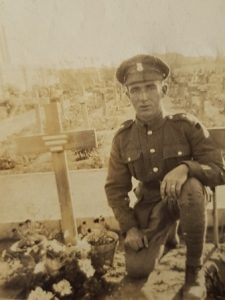
Benjamin Owen Williams, Private, 141568, Machine Gun Corps. Benjamin was the son of Humphrey and Margaret Williams, of 3, Glynafon Terrace, Dolgellau. He enlisted at Liverpool into the King’s Shropshire Light Infantry, and served with the regiment in France before being transferred to the 20th Battalion, Machine Gun Corps following its formation at Ercheu on 15 March 1918, as part of the 20th (Light) Division. The newly formed battalion moved into positions at Ham and Aubigny, in the Somme valley, on 20 March 1918, and prepared for the German assault that was obviously coming. At dawn on the following day the Germans opened an intensive artillery barrage along the line running from Croisilles down to La Fère, following up the artillery with cloud gas, then waves of German infantry attacked. The 20th Division was in the reserve line of defence, and on the following day, 22 March 1918, was hit hard by the German advance. Benjamin was killed near Aubigny during the days fighting. The 19-year-old has no known grave and is commemorated on the Pozieres Memorial, France.
Evan Jones Williams, Private, 45057, Cheshire Regiment. Evan was born in 1884, the son of Edward and Margaret Williams, of Lombard Street, Dolgellau. He married Edith Lockett at Barrow, Cheshire in 1905, and the couple had a son the following year. Evan was working as a Grocer, and lodging at Dolgellau in 1911, while Edith and their son Herbert were living with her parents at Stamford Bridge, near Chester. Evan enlisted at Birkenhead into the Cheshire Regiment at sometime in 1916, and when he was posted to France, joined the 1/6th Battalion, Cheshire Regiment, which was by then attached to 118 Brigade, 39th Division. Evan possibly joined the battalion after its efforts during the latter stages of the Somme offensive. During 1917 the Division fought throughout the Passchendaele offensive, and remained in the Salient over the winter. On 25 January 1918 the battalion entrained for the Somme with the Division, and by 31 January took over the line near Gouzeaucourt. The Battalion was training at Moislaines when the Germans launched their Spring offensive along the front from Croisilles to La Fère on 21 March and was Stood-To prior to marching to Longavesnes, and took over trenches in support. During the following day the battalion saw masses of Germans advancing from the direction of Roisel, before realising that they had been surrounded, so had to carry out a fighting withdrawal under heavy fire. Heavy fighting continued over the coming days as the battalion continued to withdraw, past Péronne and Harbonnières until being relieved on 31 March, and the entire Division was moved north to Arques, near St. Omer, to rest and rebuild. By now the Germans had launched a second offensive along the Lys, and the Division was moved back into the Ypres Salient, taking up positions at Voormezeele, where the Germans hit them again on 27 April. The Division was then moved slightly south to dig in and help in the defence of Hazebrouck. German attention then switched to the Aisne sector, so the 39th Division at last had a chance to rebuild. Evan was killed in action during a quiet period in the line on 17 June 1918, just before the Division became a training formation for American troops arriving in France. The 33-year-old is buried in Marfaux British Cemetery, France.
Hugh Williams, Private, 241673, Welsh Regiment. Hugh was the son of Thomas and Jane Williams, of Upper Court, Dolgellau. He had worked as a farm labourer prior to moving to Llanwonno by 1911 to work as a coal miner. Hugh married Ellen Hughes, of 9, Rock Terrace, Old Ynysybwl, early in 1914, and the couple had two sons over the next two years. Hugh enlisted at Pontypridd into the 2/5th Battalion, Welsh Regiment in 1915, and during 1916 was posted to Egypt, joining the 1/5th Battalion, Welsh Regiment, which was attached to 159 Brigade, 53rd (Welsh) Division. The Division had been evacuated from Gallipoli in December 1915, moving to Egypt to join the EEF, and helped guard the Suez Canal before taking part in operations to drive the Turks out of the Sinai. The EEF then turned its attention onto driving the Turks out of Palestine, and on 26 March 1917 launched its first offensive against the coastal city of Gaza, which guarded the road to Jerusalem. Initial gains during the day were lost when the assaulting divisions lost touch with each other and communication broke down when a thick fog cloaked the battlefield. Hugh was killed in action during the fighting that day. The 28-year-old has no known grave and is commemorated on the Jerusalem Memorial, Israel.
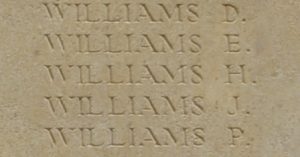
Meredith Richard Williams, Private, 291911, Royal Welsh Fusiliers. Meredith was the son of Griffith and Jane Williams, of Dolgellau. He married Winifred Evans in 1909, and the couple lived at 1, Railway Terrace, Dolgellau. Meredith worked as a florist and had served with the 3rd Volunteer Battalion, Royal Welsh Fusiliers and the 7th Battalion, Royal Welsh Fusiliers prior to the war. Meredith re-enlisted at Dolgellau into the 7th Battalion, Royal Welsh Fusiliers on 27 April 1914 and attended the annual TA summer camp at Aberystwyth in July. The battalion was a Territorial unit, which mobilised for war at Newtown in August 1914, as part of North Wales Brigade, Welsh Division and moved to Conway until the end of the month, before moving to Northampton. In December the Division moved to Cambridge and then in May 1915 to Bedford, where the Division was numbered and the formation became 158 Brigade, 53rd (Welsh) Division. On 19 July 1915 the entire Division sailed from Devonport for Imbros and on 9 August 1915 landed at Suvla Bay. Meredith was posted as missing during heavy fighting on the following day, 10 August. He was found to have been wounded and was evacuated aboard the Hospital Ship Salta to St Andrews Hospital, Malta, before returning to England, and for a short period was attached to the 3/7th Battalion, Royal Welsh Fusiliers, at Park Hall, Oswestry, before being discharged as medically unfit on 26 April 1916. Three months later he received call-up papers and enlisted back into the 3/7th Battalion, Royal Welsh Fusiliers. Although placed in medical category C, he was sent overseas again and embarked at Southampton for Egypt aboard the SS Cameronia on 2 April 1917. On 15 April 1917 the Cameronia was some 150 miles east of Malta when she was torpedoed and sunk by the German submarine U-33, with the loss of 210 lives. Meredith was 32 years old when he drowned during the sinking and is commemorated on the Chatby Memorial, Alexandria, Egypt.
Robert Williams, Private, 345654, Royal Welsh Fusiliers. Robert was born at Capel Curig in 1885, the son of Rowland Williams and Mary Williams (nee Ellis). The family later came to live at Mount Pleasant Road, Dolgellau. Robert married Anne Williams, of Llanberis, on 29 September 1913, and the couple settled at Cil Melyn, Warden Street, Llanberis, where their three children were later born. Robert then enlisted at Llanrwst into the 16th Battalion, Royal Welsh Fusiliers on 20 December 1914, before joining the battalion at Llandudno. He did not embark for France with the battalion in December 1915, but remained in England with the 20th RWF for a while, as he had been released from duty for munitions work at the Dolgarrog Works at Talycafn. On 22 January 1917 he was posted to the 3rd RWF, then on 16 February 1917 was drafted to Egypt, embarking at Southampton for Alexandria, before being posted to the newly formed 24th Battalion, Royal Welsh Fusiliers. The battalion had been formed from the Denbighshire Yeomanry in Egypt on 1 March 1917, joining 231 Brigade, 74th (Yeomanry) Division, and saw its first major action during the Second Battle of Gaza on 17 April. The battle was a failure, and the EEF was re-organised under a new commander, Sir Edmund Allenby. Robert was shot in the head whilst on duty in the Sinai on 15 July 1917 and evacuated to the 66th Casualty Clearing Station where he died that same day. The 31-year-old was buried in ‘M’ Cemetery, 281 at Deir El Belah, which was later renamed Deir El Belah War Cemetery, Israel. He is also commemorated on the Llanberis War Memorial.
Robert Percy Williams, Private, 2156, Welsh Guards. Robert, known as Percy, was born in Cardiff in 1897. He was the grandson of Robert Williams, Bryntirion Lodge, Bontddu. His parents died soon afterwards and he went to live with an aunt, Alice Fowler, at Barry Dock, then with another aunt, Maggie Jones, of Bridgend and of Lawn Cottages, Dolgellau. He enlisted at Llangollen into the Welsh Guards in the summer of 1915. The Regiment was raised by Royal Warrant of 26 February 1915, at White City, before landing at Le Havre on 18 August 1915, becoming attached to 3rd Guards Brigade, Guards Division. The Division saw its first major action during the Battle of Loos, which began on 25 September 1915, and suffered heavy casualties at Hill 70, then in the subsequent Action of Hohenzollern Redoubt. In July 1916 the Division moved to the Somme, taking part in the Battle of Flers-Courcelette, and then fought at the Battle of Morval, capturing Lesboeufs Village. The Guards remained here for the winter, and in March 1917 took part in the advance caused by the German Retreat to the Hindenburg Line. Later that year the Division moved north to Ypres, taking part in the Battle of Pilckem Ridge on 31 July, and then saw further fighting at Poelcapelle and the First Battle of Passchendaele. November saw the Division move south again, to take part in the Battle of Cambrai. By 22 November the Guards had reached Achiet-Le-Petit, and on the following day moved into the battle area, relieving the battered 51st (Highland) Division at Flesquières on 24 November. One Company of the Welsh Guards were sent to support the attack on Bourlon Wood, and on the 26th the entire battalion moved forwards to take part in the fighting east of the wood. The Germans counter-attacked on 30 November and broke through, so the Guards Division was ordered to secure Gauche Wood and Gonnelieu Spur. Percy was killed in action during ferocious fighting when the Welsh Guards attacked the Germans here on 1 December 1917. The 20-year-old has no known grave and is commemorated on the Cambrai Memorial, Louverval, France.
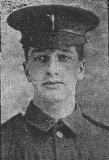
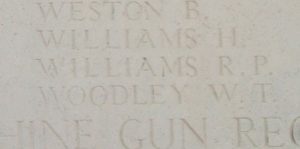
William Williams, Private, 60926, Royal Welsh Fusiliers. William was born at Llanuwchllyn in 1897, the son of John and Jane Williams. His mother was from Rhydymain. By 1911 the family was residing at Station House, Rhos, Ruabon. William enlisted at Dolgellau into the Royal Welsh Fusiliers in 1917, and after completing his training was posted to France, joining the 2nd Battalion, Royal Welsh Fusiliers, which in February 1918 had joined 115 Brigade, 38th (Welsh) Division. The Division was in the Armentieres sector, but at the end of March was rushed south to the Somme, to relieve the battered 2nd and 47th Divisions in the line north of Albert, facing Bouzincourt Ridge. The Division then took part in several small-scale assaults against the Germans to gain control of the ridge and thus afford a view across the Ancre valley towards Thiepval Ridge. On 21 August 1918 the Division crossed the flooded River Ancre and captured Thiepval Ridge and Pozieres, before launching their advance across the old Somme battlefields towards the Hindenburg Line. The Division saw heavy fighting whilst advancing through Longueval and Delville Wood, then at Morval and Sailly-Saillisel over the coming days and by 11 September had reached the outskirts of Gouzeaucourt. By 18 September the 2nd RWF had taken up positions on Fins Ridge and took part in the fighting to clear Dessart Wood. William was wounded here, and evacuated to the 3rd Casualty Clearing Station where he died of his wounds on 21 September 1918, aged 21. He is buried in Thilloy Road Cemetery, Beaulencourt, France.
———————————————————————————
World War Two, 1939-1945
Alexis Alexisovich Aladin, Sub Lieutenant, Royal Naval Volunteer Reserve. Alexis was the son of Alexis Theodoravich Aladin, a naturalised Russian, and Florence Irene Aladin. His parents had come to live at Tynewydd, Dolgellau prior to the war. Alexis enlisted into the Royal Naval Volunteer Reserve, and trained as a pilot with the Fleet Air Arm. He was posted to 785 Naval Air Squadron, which was based at the Fleet Air Arm Station HMS Jackdaw, at Crail, Fife, Scotland for training. On 3 January 1945, Alexis was flying a Fairey Barracuda II, Serial MD801 on a training flight, and was carrying out an attack on a target ship when the aircraft struck it and crashed into the sea, killing Alexis and his two fellow crewmen. Alexis was 21 years old when he was killed that day, and is commemorated on the Lee on Solent Memorial, Hampshire.
Mary Rosamund Kathleen Bennett, Junior Commander, 218699, Auxiliary Territorial Service. Mary was born in Newton Abbott, Devon in 1915, the daughter of Doctor Robert Allan Bennett and Gladys Rosamund Bennett (nee Jelf-Reveley). Her mother’s family was from Gilfachwydd, Dolgellau. Mary enlisted into the Auxiliary Territorial Service and was commissioned as a Junior Commander in February 1942. Mary was serving in Italy when she died in Naples on 8 August 1944, aged 28. She is buried in Naples War Cemetery, Italy.
Evan Emrys Davies, Private, 4195553, Border Regiment. Evan was the son of Evan Rees Davies and Margaret Sarah Davies (nee Evans), of 1, Water Street, Dolgellau. He enlisted into the army and was posted to the 4th Battalion, Border Regiment, which was a TA battalion, originally attached to the 126th Infantry Brigade, 42nd (East Lancashire) Division. The battalion transferred to the 25th Brigade following the outbreak of war and embarked for France to serve with the BEF, before being evacuated from Cherbourg. It was then posted to South Wales on garrison duties before embarking for North Africa in 1941, taking part in the fighting around Tobruk before being posted to India in 1942, becoming part of Orde Wingate’s famous Chindit force. Evan was killed in action near Imphal, India on 28 July 1944, aged 26. He is buried in Imphal War Cemetery, India.
Evan Williams Edwards, Captain, Royal Welch Fusiliers. Evan was the son of William and Elizabeth Edwards, of Llanelltyd. He married Violet Anne Tyrrell in Ludlow in 1939, and the couple lived at Pil-yr-Hengwrt, Dolgellau. Evan served with the 11th Battalion, Royal Welch Fusiliers, which was a home service unit. He died at the Moston Hall Military Hospital near Chester on 2 September 1944, aged 51. His remains were brought home and he was buried in Llanelltyd Cemetery on 5 September.
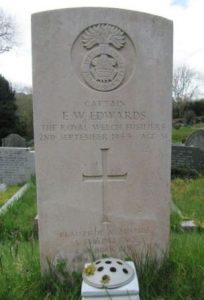
William Henry Ellis, Flight Sergeant, 1021328, Royal Air Force Volunteer Reserve. William was born on 8 May 1911, the son of William Ewart Ellis and Alice Emmeline Ellis (nee Rigby). His parents later came to live at South Lodge, Dolmelynllyn, Dolgellau. William married Mary Florence Stevens in 1939 and the couple lived on the Wirral. William enlisted into the Royal Air Force Volunteer Reserve and after training as an Observer was posted to 75 Squadron, RAF, which was a heavy bomber squadron, based at RAF Newmarket. He had flown at least seven missions prior to taking off from Newmarket aboard a Short Stirling III, Serial BF506 on the night of 20-21 April 1943, as part of a force sent to bomb the Heinkel factory at Rostock. During the early hours of the following morning, 21 April 1943, the Stirling was intercepted by a German night-fighter and shot down near Jutland, Denmark, killing all of her crew of seven. William was 31 years old when he was killed during the crash, and is buried in a communal grave in Esbjerg (Fourfelt) Cemetery, Jutland, Denmark.
Gwilym Gray Evans, Private, 4208436, Parachute Regiment. Gwilym was the son of Griffith Evans and Elizabeth Catherine Evans (nee Edwards), of Dolgellau. He enlisted into the Royal Welch Fusiliers on 19 April 1941, then volunteered to serve in the newly formed Parachute Regiment. He completed his Parachute Training Course in October 1942, before being posted to the 1st Battalion, Parachute Regiment, and took part in operations in North Africa, Sicily and Italy. The battalion then returned to England to prepare for D-Day, and Gwilym’s battalion then took part in Operation Market Garden, the landings at Arnhem. He escaped across the river, as shown in the famous film ‘A Bridge Too Far’, and returned to England. Gwilym was killed on manoeuvres on Exmoor on 16 April 1945, aged 20. His remains were brought home for burial in Dolgellau Nonconformist Cemetery.
Lewis Evans, Sergeant, 1212800, Royal Air Force Volunteer Reserve. Lewis was the son of Rowland Evans and Magdalene Evans (nee Edwards), of Brithdir. He enlisted into the Royal Air Force Volunteer Reserve, and trained as a Pilot before being posted to 165 Squadron, RAF. The squadron had reformed at RAF Ayr on 6 April 1942, equipped with Supermarine Spitfires. Lewis appears to have been aboard the aircraft carrier HMS Eagle, and was lost in the Mediterranean after taking off from Eagle on 21 July 1942. Lewis was 23 years old when he died that day and is commemorated on the Malta Memorial, Malta.
Richard Griffiths, Private, 4207134, Royal Army Ordnance Corps. Richard was born on 17 April 1910, the son of Evan and Gwen Griffiths, of Jerusalem, Trawsfynydd. He married Kate Ann Edwards, of Ganllwyd, in 1939. Richard enlisted into the Royal Army Ordnance Corps, and was posted out to the Middle East, to Iraq. Nothing further is known of his military service, but Richard died in Iraq on 12 June 1942, aged 32. He is buried in Basra War Cemetery, Iraq.
Robert Ellis Hughes, Private, 4185930, South Staffordshire Regiment. Robert was born in Treharris on 20 May 1908, the son of William and Mary Alice Hughes. His father was from Dolgellau and was killed at Ypres in 1914. Robert lived at 57, The Butts, Coventry prior to the war and married Bertha Whitehead (nee Fickling) there on 11 August 1942. Robert was already serving with the 11th Battalion, South Staffordshire Regiment when he married Bertha, and soon afterwards was posted out to India, joining the 1st Battalion, South Staffordshire Regiment, which was attached to Orde Wingate’s famous Chindit force. Robert took part in the Chindits second operation in Burma, and died in India on 14 January 1945, aged 36. He is buried in Kirkee War Cemetery, India.
Arthur Jones, Sapper, 1941350, Royal Engineers. Arthur was born in Kensington on 10 July 1917, the son of Owen and Ceridwen Jones. He was the husband of Maye Jones, of Dolgellau. Arthur enlisted into the Royal Engineers and was posted to the 933rd Port Construction and Repair Company. Little else is currently known of him, but Arthur died on 4 December 1942, aged 31, and is buried in Dolgellau Nonconformist Cemetery. Arthur is not commemorated on the Dolgellau memorial.
Charles Alex Wynne-Jones, Lieutenant, 73168, King’s Royal Rifle Corps. Charles was born in Kensington on 14 September 1919, the son of Major Charles Wynne-Jones and Sybil Mary Gella Wynne-Jones (nee Scott), of Penmaenucha, Dolgellau. He was commissioned into the 1st Battalion, Kings Royal Rifle Corps, which was deployed to North Africa at the outbreak of war, as part of Pivot Group, near Wadi el Nagamish, Egypt. Charles had not been in North Africa long when he was killed in action on 7 April 1941, aged 23. He has no known grave and is commemorated on the Alamein Memorial, Egypt. His brother Ronald was also killed during the war.
Richard Einion Jones, Gunner, 11277112, Royal Artillery. Richard was born at Dolgellau in 1923, the son of Police Constable Louis Jones and Gwen Ellen Jones (nee Richards). The family later resided at Colwyn Bay. Richard enlisted into the Royal Artillery and was posted to Egypt with the 71st Heavy Anti-Aircraft Regiment, Royal Artillery. The regiment was a Territorial unit and originally helped guard Rosyth Dockyard. In November 1942 the regiment embarked for North Africa to take part in Operation Torch. The regiments guns were used to guard airfields in Tunisia. Richard was killed in Tunisia on 25 August 1943, aged 20. He is buried in Medjez-El-Bab War Cemetery, Tunisia.
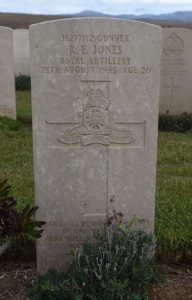
Frederick Jones, Gunner, 5392189, Royal Artillery. Frederick was born at Cerrigydruidion in 1917. He lived at Dolgellau prior to enlisting into the Royal Artillery, and was posted to the 59th Anti-Tank Regiment, a Territorial unit, which had been formed from the 6th Battalion, The Hampshire Regiment. The Regiment was attached to the 43rd (Wessex) Division and embarked for Normandy two weeks after D-Day, assembling near Bayeux on 24 June 1944. The division’s first action, was during Operation Epsom, which was launched on 26 June, and saw the Division take part in heavy fighting around Cheux when it was counter-attacked by German Panzers. By 29 June the Division crossed the River Odon and dug in before beating off another counter-attack. The division’s first major action by itself was during Operation Jupiter, the assault to take Hill 112, and was launched on 10 July. The Division was facing the formidable German 10th SS Panzer Division, and suffered heavy casualties when the Germans sent in the Tiger tanks of the 102nd SS Panzer Heavy Battalion into the fight. Frederick was killed during heavy fighting for Hill 112 on 12 July 1944, aged 27. He is buried in St. Manvieu War Cemetery, Cheux, France.
Ivor Wynne Jones, Trooper, 7909228, Royal Armoured Corps. Ivor was born on 14 February 1920, the son of William Jones and Elizabeth Jones (nee Owens), of 4, Aberwnion Terrace, Dolgellau. He worked as a Motor Mechanic prior to the war. Ivor enlisted into the army and was posted to the 142nd Regiment (7th Suffolk), Royal Armoured Corps. The regiment landed at Algiers on 1 February 1943 and took part in Operation Ochsenkopf during early March, a German offensive which was to be the last major offensive launched by the German 5th Panzer Army due to the heavy losses suffered. On the night of 19/20 April 1943 the Allies launched a massive offensive intended to end German resistance in Tunis, recapturing Enfidaville during the following day. The Germans counter-attacked, but the Allies pressed on during the morning of 22 April 1943, when the 46th Division smashed through the German lines, allowing the 6th Armoured Division to break through. Ivor was killed during the fighting of 22 April 1943. The 23-year-old is buried in El Alia Cemetery, Algeria.
Ronald Wynne Jones, Lieutenant, 132569, Royal Armoured Corps. Ronald was the son of Major Charles Wynne-Jones and Sybil Mary Gella Wynne-Jones (nee Scott), of Penmaenucha, Dolgellau. He was commissioned into the Royal Dragoons, a cavalry regiment. The regiment mechanised shortly after the outbreak of the war and was transferred to the Royal Armoured Corps in 1940, before being deployed to the Western Desert as the Reconnaissance Regiment for the 1st Armoured Division. Ronald was killed in action near Benghazi on 13 January 1942, aged 22. He has no known grave and is commemorated on the Alamein Memorial, Egypt. His brother Charles was also killed during the war.
Dewi Cynfal Lewis, Private, 5625562, Devonshire Regiment. Dewi was from 18, English Terrace, Dolgellau. He enlisted into the army and was posted to the 1st Battalion, Devonshire Regiment. At the outbreak of war, the battalion was at Rawalpindi in India, then in 1940 trained in mountain warfare before taking part in operations against local tribesman, but following the Japanese invasion of Burma the battalion was sent to Lahore, joining the 20th Indian Division, before moving into Burma in the summer of 1943 and started patrols along the Chindwin River. The battalion saw heavy fighting following the Japanese offensive in March 1944, before taking part in the advance which followed the Japanese withdrawal. In July 1944 the battalion was withdrawn to Imphal to prepare to take part in the advance to Mandalay, and re-joined the offensive in November 1944, seeing heavy fighting between the Irrawaddy and Kyaukse, south of Mandalay. One New Year’s Day the battalion crossed the Chindwin and on 22 February 1945 assaulted and captured Kanlan. In early March the battalion fought at Sinbyugan before attacking Gyo, then towards the end of March attacked Letpanpin. Dewi was killed in action here on 24 March 1945, aged 29. He is buried in Taukkyan War Cemetery, Myanmar.
Edward Lewis, Sergeant, 983657, East African Artillery. Edward was the son of John Lewis and Mary Anne Lewis (nee Williams), of Dolgellau. He enlisted into the army and was posted to the 301st Field Regiment, East African Artillery. On 5 February 1944 Edward and his regiment had boarded the SS Khedive Ismail at Mombasa. The ship was bound for Colombo carrying 1,324 passengers including 996 members of the East African Artillery’s 301st Field Regiment, 271 Royal Navy personnel, 19 WRENS, 53 nursing sisters and their matron, nine members of the First Aid Nursing Yeomanry and a war correspondent, Kenneth Gandar-Dower, and had sailed as part of Convoy KR8, escorted by the heavy cruiser HMS Hawkins and destroyers HMS Paladin and HMS Petard. Early in the afternoon of Saturday 12 February 1944 the Convoy was steaming south-west of the Maldives, when Gunners aboard Khedive Ismail spotted the periscope of an attacking Japanese submarine, the I-27 and opened fire on it. Simultaneously the submarine fired a spread of four torpedoes, two of which hit Khedive Ismail, which sank in three minutes. The survivors jumped into the water, some grabbing Carley floats, whilst HMS Paladin launched her lifeboats to gather the survivors. The Japanese submarine dived beneath the survivors in an attempt to stop depth-charges from being fired onto her, but due to the hazards involved in her potentially escaping, HMS Petard fired three patterns of depth-charges, forcing the submarine to surface. The two destroyers proceeded to fire at the submarine, but Paladin struck her, cutting a hole in her own hull. The Japanese again dived below the survivors, so Petard resumed the attack, destroying the submarine, but also killing most of the survivors in the water. Of the 1,511 people aboard, only 208 men and 6 women survived. Edward was 23 years old when he died that day, and is commemorated on The East Africa Memorial, Nairobi, Kenya.
Eric Hall Lewis, Fusilier, 4195139, Royal Welch Fusiliers. Eric was the son of Lewis Lewis and Kate Anne Lewis (nee Roberts), of Ivy Cottage, Dolgellau. He enlisted into the army and was posted to the 1st Battalion, Royal Welch Fusiliers. The battalion was in France with the BEF in 1940 and suffered heavy casualties whilst defending the crossings of the La Bassée canal before the survivors were evacuated from Dunkirk. After two years spent in Britain the 1st RWF was posted to India with the 2nd Division. Eric was killed in Burma on 18 March 1943, aged 23. He has no known grave and is commemorated on the Rangoon Memorial, Myanmar.
Arthur Maelor Owen, Sergeant, 742226, Royal Air Force Volunteer Reserve. Arthur was the son of Morgan Maelor Owen and Mabel Jane Owen (nee Edwards), of Dolgellau. He married Mary Gertrude Davis in 1939 and the couple lived at 96, Trentham Road, Longton, Staffs. Arthur enlisted into the Royal Air Force Volunteer Reserve following the outbreak of war and trained as a Pilot before being posted to No 2 School of Air Navigation at RAF Cranage. On 17 February 1941, Arthur took off from Cranage flying an Avro Anson I, Serial K6283 on a navigational training flight to Holmes Chapel. The aircraft flew into cloud, and whilst attempting to escape the cloud, the Anson hit rising ground and crashed, sliding upside down into a water-filled ditch. His two fellow crew-men, although injured, managed to escape the wreck, but Arthur drowned in the accident. The remains of the 25-year-old were brought home for burial in Dolgellau Nonconformist Cemetery.
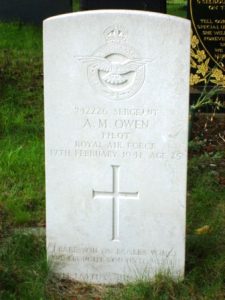
Malcolm David Owen, Corporal, 2359273, Royal Corps of Signals. Malcolm was born on 15 November 1908, the son of Hugh and Gertrude Owen, of Llanelltyd Post Office, Dolgellau. He worked as a Postman prior to marrying Edith Mary Davies, of Newtown, Montgomeryshire, in 1941. He had enlisted into the Royal Corps of Signals and had been posted to the 48th Light Anti-Aircraft Regiment, Royal Artillery Signals Section. The Regiment sailed for the Far East from Gourock on the day Japan declared war, aboard the SS Duchess of Athol, and disembarked at Tanjong Priok Harbour, Batavia, Java, joining ABDA Force. The Japanese invaded Java on 28 February 1942, and after less than two weeks of fighting, Java was surrendered to the Japanese on 12 March. Malcolm and the surviving members of his Regiment were taken into captivity and taken to a POW camp in Batavia. Malcolm survived over three arduous years in Japanese captivity, but following the Japanese surrender took ill and died of malaria at Kauching Camp POW Hospital, Borneo on 23 August 1945. The 37-year-old is buried in Labuan Cemetery, Malaysia.
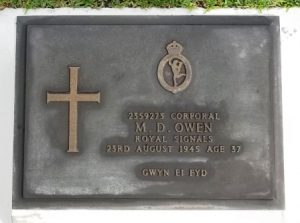
Samuel Frederick Osborne Wood Pickvance, Leading Seaman, D/JX/143645, Royal Navy. Samuel was born at South Shields on 14 December 1919, the son of Jack and Lilian Pickvance. He married Doris Turner, of Whalley Range, Lancashire, in 1941. Samuel enlisted into the Royal Navy and served aboard the T-Class submarine HMS Traveller. She had been launched in August 1941 and spent most of her career in the Mediterranean. Traveller left Malta on 28 November 1942 for a patrol in the Gulf of Taranto, tasked with carrying out a reconnaissance of Taranto harbour for a Chariot human torpedo attack, code-named Operation Principal. The submarine did not return from the operation and was reported overdue on 12 December. Traveller is presumed to have struck an Italian mine on or about 4 December 1942. Samuel was lost in the sinking of Traveller. The official date of his death. 12 December 1942, is the date Traveller was reported as overdue. The 22-year-old is commemorated on the Plymouth Naval Memorial, Devon.
Ifor Wyn Pugh, Sergeant, 1583491, Royal Air Force Volunteer Reserve. Ifor was the son of Hugh Pugh and Catherine Pugh (nee Roberts), of Bontddu. He enlisted into the Royal Air Force Volunteer Reserve and trained as a Flight Engineer before being posted to 427 Squadron, RAF. The Squadron had formed on 7 November 1942 at RAF Croft as part of No. 4 Group. Two months later the Squadron was transferred to No. 6 (Royal Canadian Air Force) Group, initially equipped with the Vickers Wellington. The Squadron moved to RAF Leeming in May 1943 and re-equipped with the Handley Page Halifax four-engine bomber. On the night of 17 August 1943, Ifor took off from RAF Leeming aboard Halifax V, Serial DK243, which was part of a force despatched to bomb the Nazi rocket research centre at Peenemünde. The raid was a success, causing heavy damage at the facility, and the surviving bombers began their return flight. Soon afterwards, Ifor’s aircraft was intercepted by a German night-fighter and was hit. Only two men managed to bale out, Ifor and four others were killed when their Halifax crashed at Wusterhusen on the morning of 18 August 1943. Ifor was 19-years-old when he was killed during the crash and is buried alongside his fellow crew members in Berlin 1939/45 War Cemetery, Germany.
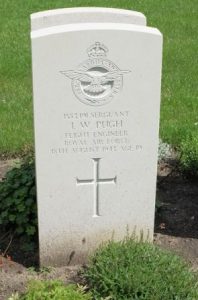
Meredith Meirion Pugh, Private, 14411528, Welch Regiment. Meredith was the son of Edward Pugh and Elizabeth Pugh (nee James), of Dolgellau. He enlisted into the 4th Battalion, Welch Regiment, which was a Territorial unit, based in west Wales, and was attached to the 53rd (Welsh) Division. The Division was moved to Northern Ireland at the outbreak of war, before returning to England, spending much of the war on home defence before landing in Normandy at the end of June 1944 and at dawn on 27 June the 4th Welsh disembarked, before the Division concentrated between Caen and Bayeux. It’s not presently known if Meredith embarked for France with the battalion, but if so, he was possibly wounded during the battalion’s actions near Évrecy and the Le Bon Repos crossroads, before returning home for treatment at Swansea Hospital. He died in Swansea on 27 September 1944, aged 19. His remains were brought home for burial in Dolgellau Nonconformist Cemetery.
Emlyn Roberts, Aircraftman 1st Class, 1161102, Royal Air Force Volunteer Reserve. Emlyn was possibly born at Dolgellau on 13 September 1916, the son of John Roberts and Mary Ellen Roberts (nee Davies). He enlisted into the Royal Air Force Volunteer Reserve and was posted to Seletar, Singapore with No 4 Anti-Aircraft Co-operation Unit, RAF. Following the Japanese invasion of Singapore on 8 February 1942, the British embarrassingly surrendered on 15 February, after a week of desperate fighting and 80,000 prisoners were marched into captivity. Emlyn’s unit had been wiped out, but nothing is known of his fate. He is officially commemorated as having died on 1 February 1943 and is commemorated on the Singapore Memorial, Kranji. (It is not currently known if this is the correct man, but there is no-one named Emlyn Davies with definite ties to Dolgellau).
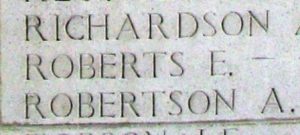
Joseph Idris Rowlands, Fusilier, 4195636, Royal Welsh Fusiliers. Joseph was the son of Christmas Rowlands and Ila Mary Rowlands (nee Jones) of Dolgellau. He had enlisted into the Royal Welch Fusiliers prior to the war and had embarked for France with the BEF, being attached to the Auxiliary Militia Pioneer Corps. Following the German Blitzkrieg, the carious elements of the BEF, as well as countless civilians, had been forced to withdraw to the French coast for evacuation. The thousands of troops who had made it to Dunkirk had already been evacuated by 6 June, whilst more had been evacuated from Boulogne, Calais and Le Havre by 25 May. More Allied troops had managed to reach ports in other parts of France, stretching from Cherbourg down to Bayonne, so the British organised Operation Aerial, to evacuate Allied forces and civilians from western France. Joseph had managed to reach St. Nazaire. On 17 June 1940 the requisitioned RMS Lancastria steamed into the Loire Estuary and anchored in the Charpentier Sounds. By the afternoon Lancastria had taken aboard a huge number of evacuees, far greater than she was built to carry, with estimates running from 4,000 to 9,000 people. The Germans had already begun attacking shipping in the area, and at 15.50 Lancastria was attacked by Junkers-88 bombers and sank in less than 20 minutes. An estimated 6,500 people drowned in the sinking of Lancastria that day. Joseph was 20-years-old when he drowned in the Loire. His body was later recovered and buried in Les Moutiers-en-Retz Communal Cemetery, France.
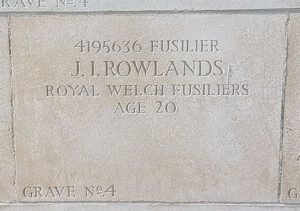
Thomas Bodley Scott, Lieutenant, 90701, Royal Berkshire Regiment. Thomas was born in Secunderabad, Madras, India in 1909, the son of Major Herbert Bodley Scott and Sybil Claudia Jane Scott (nee Jelf-Reveley). His parents later lived at Sybil’s native Brynygwin Isa, Dolgellau. Thomas was educated at Cambridge, graduating BA and had become a Solicitor before he married Muriel Kate Taylor, a Nurse, in 1939. The couple took up residence at Brynygwin Uchaf, Dolgellau. Thomas had been commissioned into the 1st Battalion, Royal Berkshire Regiment. He died on active service in Scarborough on 8 July 1940, aged 30, and is buried in Scarborough (Manor Road) Cemetery, Yorkshire. Thomas had probably served in France with the BEF, and either been wounded or taken ill.
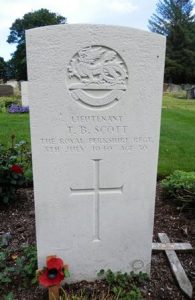
Thomas Owen Tippett, Private, 4194590, Parachute Regiment. Thomas was the son of Edward Foulkes Tippett and Anne Mary Tippett (nee Luke), of Dolgellau. He had enlisted into the 10th Battalion, Royal Welch Fusiliers. The battalion became the 6th (Royal Welch Fusiliers) Parachute Battalion of the Parachute Regiment in 1942, and Thomas undertook his parachute training in August 1942. The battalion was sent to Tunisia in 1943, to prepare for operations in Sicily and Italy. The 1st Airlanding Brigade and 1st Parachute Brigade suffered heavy casualties in Sicily, so when it was proposed that the division take part in the landings at Taranto, on mainland Italy, code-named Operation Slapstick, only the 2nd Parachute Brigade and 4th Parachute Brigade were up to strength Thomas and the other men of the 6th Parachute Battalion embarked aboard the minesweeper HMS Abdiel. She was steaming into Taranto Harbour on 10 September 1943 when she struck a German mine and sank with the loss of 58 men of the battalion, including Thomas. The body of the 21-year-old was later recovered and he was buried in Bari British Military Cemetery, Italy on 20 October 1944.